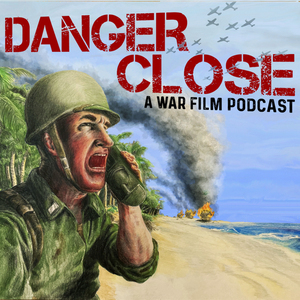We Were Soldiers - Battle of Ia Drang
Micah Neidorfer
Army Infantry Officer, BA in History, Graduate of the US Army Command And General Staff College: Army Historian Course
Opening Scene: The film decides to start the "story" of the Vietnam war with the First Indochina War (1946-1954). However, the history of Vietnamese struggles for independence goes as far back as 111 BCE with the first Chinese occupation of Vietnam. Vietnam would end up being occupied by China four times: (111 BCE-40 AD, 43-544 AD, 602-905 AD, and 1407-1427 AD) Each time the Chinese were eventually thrown out by Vietnamese rebellion.
France began the process of colonizing Vietnam in 1958 and maintained its status as colonial power until its defeat by the Vietnamese in 1954. During the Second World War Japan briefly invaded Vietnam in 1940, but quickly returned control to the Vichy French Government (a puppet government to Germany), yet stationed troops in the country nonetheless.
It was during WWII that the seeds for the future Viet Cong (the communist guerilla forces which existed during the Vietnam War) were sown. A rising Communist movement had been growing in Southeast Asian nations since the founding of the Chinese Communist Party. However, during WWII the Indochinese Communist Party (the communist party of Vietnam) decided to focus on nationalist goals ahead of communist goals for the time being: mainly achieving independence for Vietnam from both the Japanese and the French. They formed the League For The Independence Of Vietnam (Viet Minh for short) All political groups regardless of ideology were invited to join this resistance movement, but it remained always headed by Communist leaders and mainly had a Communist body of members.
During WWII US and Allied special operations forces would aid the Viet Minh in their guerilla war. And Ho Chi Minh (the leader of the Viet Minh and a rising star in the Vietnamese Communist Party) was hopeful that the US would support Vietnam's independence from France following the defeat of the Axis Powers.
This was not to be. And after VJ Day Vietnam was returned to French Colonial Rule. Naturally, the Viet Minh turned their attention from fighting the Vichy French and Japanese forces to fighting the French Colonial Government. This war lasted from 1946 through 1954. The war began for the first few years as a low intensity guerilla war but eventually transitioned to a high intensity kinetic war, through arms, ammunition, equipment, and training being provided to the Viet Minh by the Soviet Union and China.
France (as the US later would) struggled to find effective operational and strategic methods to win the war and eventually lost the will to continue fighting, resulting in the partition of Vietnam by the Geneva Accords in 1954 into the Republic of Vietnam (South) and the Democratic Republic of Vietnam (North)
5:59 - And so begins my dislike of how infantrymen are portrayed in this film. "He's not one of those academic pussies is he?" Infantrymen, despite stereotypes of being 'macho' or 'jocks' aren't idiots. It's an unofficial rule that you have to have a masters degree to be promoted to Major, so no-one would be surprised that a Lieutenant Colonel has an advanced degree.
7:59 - I think this was acceptable in the '60s, but you wouldn't catch anyone dead drinking on duty in the Army today. (Not that people never do, but it's certainly not an OK thing to do openly, and a LTC certainly wouldn't do it.)
9:34 - In the Army it is against regulations to wear hats indoors. (You also don't salute indoors (unless it's part of a ceremony), most movies get that wrong)Same Scene - The Blue cords worn on the right shoulders indicate that that individual is in the infantry. The infantry is the only branch of the army that wears a cord on it's right shoulder. A Cavalry unit (the unit portrayed in the film is 1st Battalion 7th Cavalry Regiment 1st Cavalry Division) is an interesting convergence. Both cavalry (also known as armor) soldiers and infantry soldiers form the basis of a cavalry unit, especially an air mobile (in modern times known as air assault) unit. In an air mobile unit there is also a large contingent of aviation soldiers. In mechanized (using ground vehicles) cavalry units, there are mostly cavalry soldiers and a few infantry soldiers. But an air cav unit would have a larger contingent of infantrymen, since the role of an air cav unit is closer to that of an infantry unit.All officers wear their branch (infantry, cavalry, ordnance corps, engineer corps.. etc.) insignia on their collars in their dress and service uniforms (they are wearing service uniforms in this scene). Any officer with crossed rifles (the insignia of the infantry) should also be wearing a blue cord like LTC Moore. However it seems none of these infantry officers are.Also, (as is most often the case in war movies) everyone is a little too old. Your average Lieutenant is
22-26, your average captain is 27-32, average major is 32-39.
10:22 - Stupid, why would he salute.
11:01 - And so you can organize your soldiers and take control of the situation immediately
11:24 - Stupid, they all know what a Command Sergeant Major's job is, no one needs to be told that he works for the Battalion Commander.Every Battalion (regardless of branch) (in this case 1st Battalion of the 7th Cavalry Regiment of the 3rd Brigade of the 1st Cavalry Division) is commanded by a Lieutenant Colonel, a commissioned officer. Within a Battalion (this is for infantry and cavalry battalions (although in the Cavalry they normally call them squadrons instead of battalions, I'm not sure why 1-7 is referred to as a battalion and not a squadron, but it's not a film error, they were historically named a battalion)) there are 6 companies (4 "line" companies (of combat troops) 1 Headquarters and Headquarters Company (which contains 2 specialty platoons and the Battalion staff) and 1 support company (with mechanics, cooks, etc...) Each company has a company commander who is captain. Each "line" company has 3 platoons led by a lieutenant. Each unit and sub unit has a senior non-commissioned officer who is paired with the commissioned commander. At the Battalion level there is a Command Sergeant Major paired with the Lieutenant Colonel. At the Company level there is a First Sergeant paired with the Captain. And at the platoon level there is a Sergeant First Class paired with the Lieutenant. Every commissioned officer, no matter how new, down to the most junior lieutenant, outranks the Command Sergeant Major. But no-one would dream of telling him what to do, because he is the partner of the LTC, so if the CSM is saying something, it's effectively as if the LTC was saying it.
12:46 - This film acts as if this is some sort of revelation coming from LTC Moore, when in reality this is already how all of them are trained to be.
15:44 - This street and these houses are still at Fort Benning, I've driven past them. They look pretty much the same (I don't know if they're still from the '60s, but they're still there from the filming of the movie)
17:56 - I've never met a Command Sergeant Major who would swear at an officer unless that officer was doing something horribly wrong.(And frankly I don't think they exist or have ever existed) Even though I said earlier that a CSM, despite being outranked by every officer no matter how junior, is still de facto above all of these officers, one of the primary responsibilities of a CSM as the Battalion's senior non commissioned officer is to enforce standards and proper discipline, and swearing at a commissioned officer is not following standards or good discipline (especially in front of junior enlisted soldiers such as in this scene).
19:45 - These gatherings of spouses are actually a semi-formalized function. They are called Family Readiness Groups. There will be an FRG for the Battalion, and then each Company will have an FRG. FRGs are not mandatory for spouses but they exist to help spouses and service members maintain a healthy life inside and outside work and to build a community around the unit. They also assist in spreading news of the unit and offering assistance to spouses when units are deployed. It is common practice for commanders' spouses to head their respective FRGs.
27:48 - America's involvement in the Vietnam War (1955-1975) grew gradually. It began in 1955 with America providing materiel and funds as well as a small number of advisors to South Vietnam. It grew gradually during the late '50s and early '60s with the US providing increased economic and monetary assistance and growing the advisor presence, even sending over a small number of conventional units, such as aviation units. In 1964, following the Gulf of Tonkin incident, President Lyndon Johnson began committing large numbers of American combat troops to Vietnam. US troop numbers grew from around 2,000 in '61 to around 16,500 in '64.These troops were initially tasked with defending major important military and economic installations in South Vietnam. However General William Wesmoreland (The overall US Commander in Vietnam) pushed for US forces to be allowed to conduct offensive operations, convinced that committing US forces could end the war by 1967. Up to this point the Army of the Republic of Vietnam (ARVN) had been gradually losing ground to both VietCong guerilla forces and conventional People's Army of North Vietnam regular forces.The initial offensive commitment of US troops involved large scale search and destroy operations. Where US and ARVN troops would search the dense jungle of the Vietnamese countryside for Viet Cong and PAVN camps/complexes and then destroy those forces. The intent was to end the North's (and the VCs) ability to conduct large scale combat operations in the South. Which they had been able to do up to that point with relative ease.
32:47 This is way too few Soldiers for a BN. There should be twice as many soldiers.Same Scene - The Scarves are some cavalry thing (as an infantryman, I think they look stupid)
41:42 - No LTC would ever talk to his commanding officer (a full colonel) this way. They may only be 1 rank apart, but a Brigade Commander is nowhere near a peer of a Battalion Commander. I don't care how 'tough' you are, as a LTC you're not gonna talk shit to your boss to his face.Same Scene - This is not really how it went down. Division level intelligence gathering had pointed to there being 3 PAVN regiments in that area days prior. This information was passed down to the unit in the immediate area (3rd Brigade 1st Cav Division, of which 1-7 Cav was a part). And 1-7 Cav was assigned the mission to conduct a search and destroy mission in that area.
42:37 - No, a CSM would bring exactly what he's supposed to bring because he is supposed to set the standard and be the example for every soldier in the unit. No CSM would ever have this attitude.
44:03 - No-one is going to be holding their rifle up into the air and cheering. There may be cheering, but no-one's going to be doing it with their rifle. They're professionals, not vikings.
45:20 - Again, the CSM would absolutely be wearing his chinstrap. 1: He sets the standard. 2: It's really easy for a helmet to come off if there's nothing holding it to your head.Same Scene - LTC Moore would have been wearing his chin strap too. But we can't have ugly chin straps hiding our top billing actors' faces.
45:43 - This artillery bombardment around the landing zone is called a SEAAD mission (Suppression of Enemy Air Defense). Prior to landing helicopters, it is standard to identify likely locations for enemy emplacements in the immediate vicinity of the Landing Zone. Your intelligence section then identifies what likely weapons the enemy will have there and then you allocate assets (be they indirect fire (artillery/mortars)) , attack aviation (jets or attack helicopters)) to suppress and hopefully destroy what you have templated to be in those locations. If you are using indirect assets (again artillery or mortars, anything that you don't fire directly at something using line of sight) and you don't have an observer (as they don't in this situation since they are the first people to land at the LZ) you will conduct this mission even if there are no enemies, since you don't have someone on the ground to tell you if there is something there or not.
46:04 - The PAVN commander knows what areas around his position are usable as landing zones, as he's been there for a while and has reconned the area. Therefore, he can anticipate where the Americans will be landing and can plan an attack. Conversely, the Americans know that the PAVN know where they are able to land. So it is vital that the initial landing troops set up a defensive perimeter to allow the follow-on landings to be conducted successfully.
46:12 - That's how you accidentally shoot someone. No-one is going to take their weapon safety off while they are still in transport. Really you're not going to take your safety off until you have identified a target to fire at. And then after you have finished engaging your target you're going to put the safety back on until you have identified your next target. (Now, that is textbook, in combat sure maybe you'll keep your safety off the whole time, but no-one is going to take it off while you're still in the helicopter not being shot at.)
47:17 - This is a bit hollywood. If you get out of a helicopter into a hostile landing zone, sure, you're going to be ready to return fire. But you're not going to just start shooting preemptively. Ammunition is limited (especially in a unit conducting an air assault far from their base of operations and can only be resupplied by a 30 minute helicopter ride). That said, the helicopter gunners might fire preemptively, since they can be resupplied every time they touch back at the base, but definitely not the dismounts.
47:32 - Standing may look cool, but it's a good way to get shot. Moore and Plumley would definitely be at least kneeling. Also, the CSM isn't just going to be following the BN Commander around like a toady (he kinda does in this movie), he is going to have a job of his own. It is common, on a BN scale operation, for the BN CSM to be in charge of the BN Casualty Collection Point (CCP). So Plumley would most likely be helping the BN medical officer set that location up at this point.
48-35 - This platoon didn't become cut-off in the manner the film suggests. In reality they were moving along with their company (B Company) on a patrol. The entire company began to be engaged by PAVN troops and 2nd Platoon (the platoon in this scene) began to assault a squad of PAVN troops. 2nd Platoon came to a clearing, which doctrinal tactics would tell you to go around (you don't want to walk through open ground), however LT Herrick, the platoon leader, feared that his platoon would both become cut off from the rest of B Company and lose the enemy squad if they took the time to skirt the clearing. So he took his platoon through the clearing. It was there they came under intense enemy fire and became pinned down and surrounded. Did Herrick make a bad decision in real life? Maybe and maybe not. To his understanding of the situation there were not that many PAVN soldiers in the area and he was genuinely (and rightfully so) worried about losing contact with the rest of his company. He had to make a decision and to him he made the right one. It ended up going wrong, but we only know that in hindsight. Either way, in reality the platoon leader didn't make a stupid decision to run after a single enemy soldier as the film portrays.
49:12 - This capture of a PAVN soldier and the subsequent discovery of how outnumbered the 1-7th is actually was conducted by B CO, and Moore and Plumley were not there. The info was passed back to them via radio.
51:19 - Again, the scenes with 2nd PLT B CO are pretty inaccurate in regards to individuals. The Platoon leader actually made the order to stay put and form a defensive perimeter and had already begun calling in artillery fire missions to cover his platoon before he was killed. SGT Savage, who was the 3rd Squad Leader of the platoon, took
charge only because he was the closest leader to the radio.
52:37 - This is dumb. They don't need the Battalion Commander to tell them where to land. They already know where the LZ is, and Moore has a bunch of way more important things to be doing than waving helicopters down.
53:21 - I've never known anyone in the Army who would say "I'm glad I could die for my country" if they were dying. Once again this movie makes everyone in the army seem like all American football quarterbacks and super patriots. We're just normal people.
54:08 - Same vein as the last comment. "Tell my wife I love her"... really?
54:13 - You don't use your name in radio transmissions. You use your callsign. So Savage (as the 3rd squad leader in 2nd platoon B company) would be Bravo Two Three (Bravo Company, 2nd Platoon, 3rd Squad).
55:21 - Obviously in real life a regimental or divisional commander (or a leader at any level really) is giving instructions far more in depth than gesturing at a homemade map and saying "here, here, here".
56:27 - The same goes for you Plumley, why are you there anyway, isn't there some stuff you should be doing other than following your Battalion Commander around everywhere?
57:09 - That branch by his head ain't stopping any kind of bulletGeneral Comment - From here the film is generally truthful (until the end, which I'll touch on) to real life, in that the remainder of the battle was really just fighting to form and secure a perimeter. When a new part of the battalion landed it was plugged into the perimeter. Some of the events happen out of order historically, but that's not really that important, and understandable from a screenwriting perspective. In my opinion the understanding of exactly which company and or platoon did specifically what in which specific location of the perimeter isn't necessary to understand what is happening. I'll comment on these specifics if I feel they are necessary. But in general giving a play by play of what platoon or company did what and when isn't necessary in my opinion going forward with the battle and film.
57:51 - I can't imagine what it was like to fight back then with no hearing protection. A pistol can give you hearing loss if you're not wearing ear protection, let alone a rifle, and a machine gun is EXTREMELY loud. In the present day we have hearing protection headsets that hook into our radios and also have microphones on the outside of them. So you can hear ambient noise and people talking, but the headsets will deafen noises over a certain decibel. So you can hear conversation just fine, and you can hear and talk through your radio because it's hooked up to your headset, but your ears are completely protected. Fighting in a battle with no hearing protection must have been awful, I'm sure hearing loss was rampant.
58:36 - Coordinating attack aviation is more complex than saying "I need you to burn them out on hilltop XYZ, and giving a grid".
1:00:18 - Actually the medevac helicopters did land and began evacing troops, but only loaded 2 before calling off their mission because of the amount of PAVN fire.
1:02:32 - Once again, Moore has way too much more important stuff to be doing than 'leading' helicopters to a landing zone. Additionally, helicopters aren't going to follow someone to a landing zone. The new LZ would have been marked somehow either with high visibility panels or colored smoke.
1:06:55 - That's now how you conduct a tactical movement. They did not just get up and charge while yelling "air cav". They would have moved by platoon, and within each platoon by squad in a squad wedge formation. With 5-10 meter spacing between each soldier and at a walking pace, so that you can react to things and have situational awareness. Or they would have kept the majority of the company in place and had one platoon move forward, then that platoon would take up a static position and cover the next platoon as it moved forwards, and so forth. We don't yell and charge. It's a ridiculous scene.
1:08:53 - Once again, Moore and Plumley are just hanging around with each other... don't they work?
1:11:08 - In the modern day army aviators are required to get 8 full hours of uninterrupted sleep a night, even during combat operations. I would imagine it was similar during the Vietnam War.
1:11:43 - The way radios work is that people talk to each other on frequencies. For artillery support each fire support element (the artillery battery supporting the battalion, the battalion's mortar platoon, the attack aviation on standby) all have their own frequencies. When you talk on a radio no one knows who's talking. 1 person could be on the frequency or 100 people could be on the frequency. That's why you have to use callsigns. You can't just pick up the radio and say "I need x y and z". The other people on the frequency won't know who's talking. You have to say "Hello You (using their call sign), this is Me (using your call sign), I need x y and z"
1:27:34 - Again, ole' Plumley's just holding on to Moore's belt, he should give Moore his salary too.
1:27:51 - This is called a Reconnaissance by Fire. You engage suspected enemy locations in an attempt to get a reaction.
1:29:55 - LT Geoghegen was posthumously awarded the silver star for his attempted rescue of PFC Godboldt.
1:30:19 - Plumley looks like he doesn't know what is going on. He does have a job you know.
1:34:08 - Just to touch on how loud weapons are again. The sound design for these M16s is super quiet and weak-feeling. The M4 of today is comparable to the M16 of the early '60s and the M4 is loud and feels loud. Definitely not the most powerful or loudest weapon. But they're loud.
1:36:41 - What the radio operator is referring to is the deconfliction of airspace. In a battlespace there are numerous things in the air: mortar shells, artillery shells, helicopters, attack helicopters, propeller aircraft, jet aircraft, bombers. That would be a dangerous and chaotic situation if there was no coordination. Therefore airspace is coordinated by type of ordinance and platform. Mortar shells and artillery shells travel at certain heights depending upon how far away their target is. Their maximum height is the cut off for helicopters. So helicopters cannot fly below the maximum height of mortar and artillery shells. Transport helicopters are given a maximum height they can fly at. Then attack helicopters fly above the transport helicopters up to a given height. Above the attack helicopters are the propeller aircraft and then the jet aircraft and finally the large bombers. That way every platform that may be in the airspace is flying at levels where they know they will not fly into anyone else. If a certain platform needs to enter the airspace/level of another platform: say a helicopter needs to land in a certain location, and therefore needs to fly into the airspace of the mortar and artillery, then a coordination between the aircraft and the Fire Direction Center (the entity that controls and monitors all artillery use) happens to ensure that artillery and mortars are not allowed to fire into the air (or fire somewhere else that would cause their shells to travel through the area) until the helicopters have landed. It's a complicated task, but one that needs to be done right.
1:37:03 - None of these aircraft need to get anywhere near as low to the ground as they are depicted to drop their ordinance (and they wouldn't get that low). But it makes for a cooler scene.
1:37:30 - It was not Moore's radio operator coordinating the attack aviation, that job is done by a trained Tactical Air Controller. Historically during the battle it was an Air Force Lieutenant.
1:38:30 - This friendly fire incident did occur. And it did involve two jets, the second of which did wave off. It wasn't Moore who noticed it, it was the Air Force LT who noticed the aircraft. It is actually miraculous that it was the only one given the chaotic circumstances on the ground and reflects greatly on the LT that only one incident occurred.
1:46:55 - No, the Battalion Commander and Battalion Command Sergeant Major did not go out on their own to find missing soldiers. It's ridiculous.
1:48:00 - He should be giving hand signals with his non-firing hand, so that he can still fire his weapon if he needs to while giving the hand signal.
1:50:53 - Stupid. Why would a squad leader ask his Battalion Commander for permission to do anything? This interaction would never have happened.
1:54:12 - The remainder of the battle as depicted in the film is complete fiction. In reality between 0400 and 0800 am on the 16th the PAVN launched a series of final attacks on the American perimeter, which were fought off with small arms and heavy artillery bombardments. Also, it was still dark during most of this, unlike in the film where it is completely light out at 5 am. There was no American attack (charge) like there is in the film. The Americans stayed in their perimeter and fought off the PAVN like they had for the previous two days.By the afternoon that same day 1-7 Cav was withdrawn from the battlefield and two other battalions of the 3rd brigade took its place. They continued to have contacts with the PAVN for the next two days.
2:00:19 - Only in Hollywood do soldiers salute each other on the battlefield while giving each other sad/meaningful looks.
2:01:06 - This whole scene with the press is fictional. Because there was still sporadic fighting going on for the next two days the press wasn't brought to the battlefield on the 16th.
Ref:
We Were Soldiers Once... And Young - Hal MooreCombat Operations: Stemming the Tide, May 1965 to October 1966 - John M. Carland
Dennis Meyers
Relevant experience: U.S. Army, 1974-1980, BA & MA Economics, Economist for over 30 years for State of
California, Community College Adjunct Faculty
Historical Context:
The Battle of Ia Drang November 14–16, 1965, was the first major battle between the U.S. Army and
the North Vietnamese Army (NVA or People's Army of Vietnam (PAVN).
The battle took place in the central highlands of Vietnam, and involved the 1st Battalion, 7th Cavalry
Regiment under the command of Lieutenant Colonel Hal Moore.
In line with the new Air Mobile doctrine, about 450 Americans were inserted and immediately surrounded by
2,200 NVA soldiers.
It was the first large scale helicopter air assault and also the first use of Boeing B-52 Stratofortress strategic
bombers in a tactical support role. Indeed, close air support and heavy artillery played a crucial role in the
battle and inflicted many casualties, as it would throughout the remainder of the war.
This battle was the first major utilization of the Air Mobile tactic in which battles were fought in a "non-
linear" fashion, i.e. without establish battle lines. Helicopter mobility allowed engagements to suddenly
materialize anywhere a transport helicopter (UH-1s in this case) could land troops. Units could be
inserted with little advance notice to fight along a 360 degree perimeter. They could also be quickly
relocated as needed, and could thus keep the enemy continually off balance. Inserted units would be
supported by artillery and close air support. U.S. air cavalry units were able to attack the NVA wherever
they could locate them within the Republic of Vietnam. The immediate goal was not to hold and occupy
ground, but rather to inflict unacceptable casualties and deny the NVA the ability to freely operate
within South Vietnam.
It was considered an American tactical victory, as the Americans claimed an almost 10:1 kill ratio. The
Seventh Cavalry lost 79 men killed and 121 wounded. Estimates of NVA killed range from 630 to 1,200.
Because of this kill ratio, General William Westmoreland, the American commander in South Vietnam called
the Battle of Ia Drang a great victory. This supported his overall strategy of attrition whose goal was to inflict
casualties on the NAV and Viet Cong at a greater rate than their ability to replace them.
However, left out of the film is the fact that the NVA, on the day after disengaging with the 7th Cavalry,
ambushed a relief column killing an additional 155 Americans and wounding 124. While not a tremendous
number of casualties, it shows that the NVA was able to sustain heavy casualties repeatedly and still return to
the attack. This turned out to be a more important factor in determining the outcome of the war than
favorable kill ratios.
The nature of the war changed after this battle. The NVA took away the lesson that they could not win or
survive conventional set-piece battles with the U.S. military. Rather than engaging directly, they would come
to rely on a guerilla war approach of hit and run tactics. They would outlast the U.S. interest in the war.
Paradoxically, in 1968, this strategy culminated in the Tet Offensive and the Battle of Hue which was a
conventional urban battle, reminiscent of WW2. Again, tactically, as measured by casualties, the U.S. was
victorious, but its surprising ferocity turned U.S. public opinion against the war and cost Gen. Westmoreland
his command.
The two most prominent participants in the movie are Lt. Col. Harold G. Moore the reporter Joseph L.
Galloway who both authored the 1992 book, We Were Soldiers Once… And Young.
Moore (played by Mel Gibson) was a West Point Graduate and Korean war veteran. He was awarded the
Distinguished Service Cross for extraordinary heroism at Ia Drang and was promoted to full Colonel. After
returning from Viet Nam he served at the Pentagon, was sent to Harvard to complete an M.A in International
Relations. In 1968 he was promoted to Brigadier General and then to Major General in 1970. He retired in
1977 after completing 32 years of active service. Moore died from a stroke 2017, three days before his 95th
birthday.Joseph Galloway (played by Barry Pepper) was a contradiction to the popular post-Viet Nam war impression
that journalists were solidly anti-war. Galloway was a newspaper correspondent who worked alongside the
American troops he covered. He was awarded a Bronze Star Medal for carrying a badly wounded man to
safety while he was under very heavy enemy fire during the Battle of Ia Drang that he was covering as a
journalist. He retired as a weekly columnist for McClatchy Newspapers in January 2010. Galloway died in
2021 at the age of 79.
Less prominent in the movie was General Nguyen Huu An (played by Đơn Dương) who commanded NVA
forces in the battle. He joined the People's Army of Vietnam (PAVN)) in 1945. Later, he commanded 174th
Regiment of the 316th Division in the Battle of Dien Bien Phu, overcoming French defenses on 7 May 1954.
This marked the victory of the Viet Minh over the French ending the First Indochina War. At the climax of the
Viet Nam war in the 1975 Spring Offensive, he commanded the 2 nd Corp which captured Quảng Trị and Huế
and was instrumental in the capture of Saigon. He stayed in the military after the war, eventually being
promoted to Senior Lieutenant General. General Võ Nguyên Giáp called him the "General of Battles". He
died in 1995.
References
Harold G. Moore, Joseph L. Galloway, We Were Soldiers Once… and Young, 1992, Random House
Publishing Group.
Major Francis J. Huber, Force Design, the Airmobile Concept and Operational Art, 1999, United States
Army Command and General Staff College
Maurice Isserman, We Were Soldiers Once . . . But Hollywood Isn’t Sure in Which War, 2002, Hamilton
College
Wikipedia articles: Battle of Ia Drang, Hal Moore, Nguyễn Hữu An, Joseph L. Galloway
Kyle Pocock
I’m going to focus on the military technology presented in We Were Soldiers.
Vehicles
Vietnam introduced and evolved many technologies we now take for granted such as helicopter air-mobility, sub-caliber assault rifles, helicopter gunships, and precision bombing. As Micah and Dennis both touched on, the Battle of Ia Drang proved the concept of using the helicopter to take the fight to the enemy, especially in a country as dense and mountainous as Vietnam. Designed and successfully prototyped by Igor Sikorsky in 1939, the first helicopter was a rickety mix of pipes and blades that launched a whole new class of military vehicle.

(Sikorsky in 1939 on his invention’s maiden voyage)
Military use of the helicopter began in earnest in the Korean War as well as the French Algerian war where its ability to land nearly anywhere proved invaluable, especially in evacuating wounded soldiers from the front lines. Arming helicopters was still in its infancy, and usually only consisted of door mounted machine guns for defense from ground fire, though rudimentary gunships were experimented with. In Algeria especially, military planners began to see the appeal of using helicopters to move troops quickly to pinpoint locations compared to the relative chaos of paradropping masses of infantry onto a large area, separating them from each other among the enemy. Instead, all the helicopters could drop groups of soldiers at once, all at one landing zone, ready to fight the second they got off the chopper, with no chute to worry about or wind to blow them off course.

(French Choctaw helicopters land soldiers on a hillside in Algeria. You may remember the helicopter from Peter Cox’s first write up on Full Metal Jacket where the infamous door gunner mows down civilians.)
As shown in the film, the US decided to take these lessons to heart and constructed the first Air Cavalry units with helicopters carrying infantry to the enemy with the intention of causing as many casualties as possible, not taking and holding ground on a front line as in earlier conflicts. This simply would not have been possible without the helicopter and the prodigious amount of air power the United States had at its disposal. Though other helicopters were involved in the war like the Choctaw seen above, the Loach scout helicopter, the heavy Chinook transport, or the Cobra gunship, the Bell UH-1 Iroqouis, more commonly known as the Huey, was the main workhorse, providing the ability to lift and carry personnel, equipment, wounded soldiers, and even to mount weapons and take the fight to the enemy alongside other helicopters. Entire fleets of Hueys could prep landing zones with suppressive fire as gunships, land infantry, and continue to support them as the fighting raged on, taking wounded soldiers back to med bases, landing reinforcements or moving soldiers to new fights, and responding to ground targets with rockets and machine guns. It served as a reliable and versatile vehicle throughout the war and well on into the future, with variants still in service around the world despite being replaced in the US by the UH-60 Black Hawk.
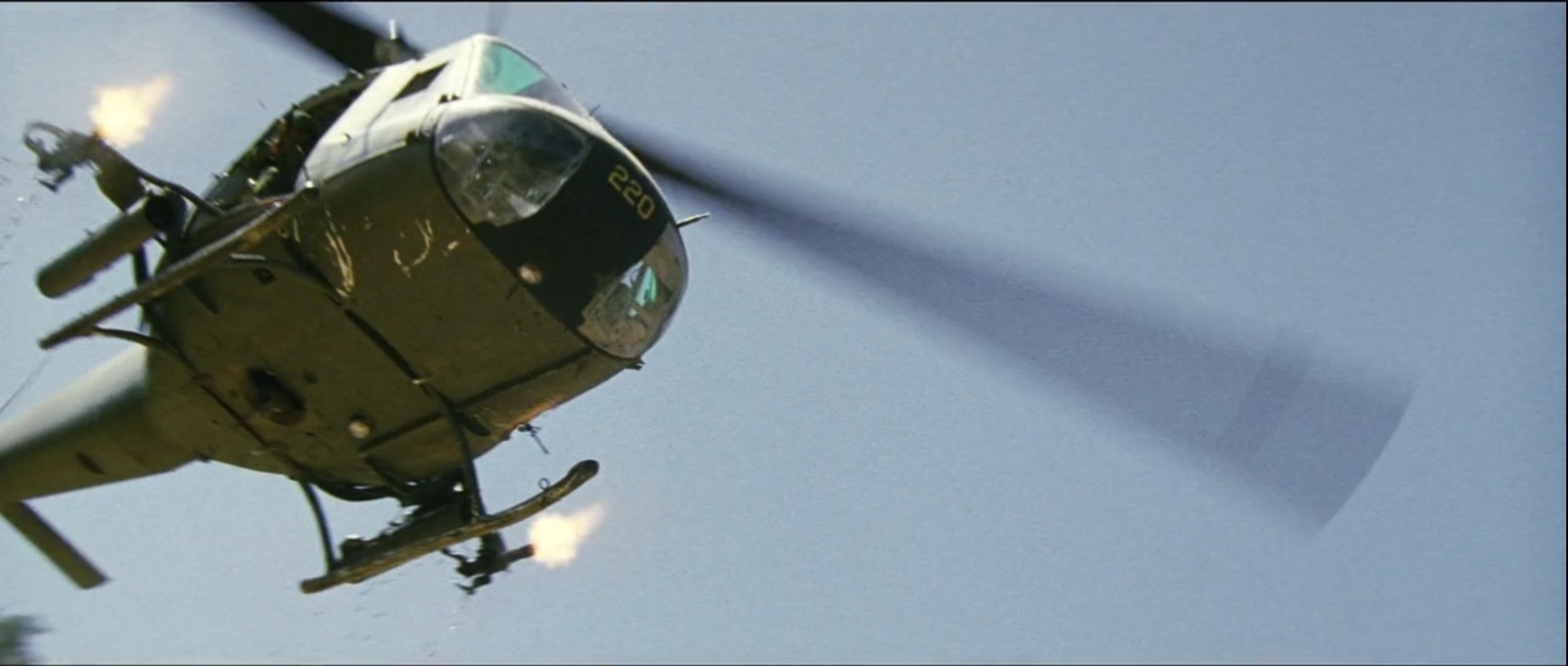
(Snake shit saves the day in a Huey loaded with a common XM-21 gunship setup of twin 7.62 M134 miniguns and rocket pods complimented by the usual door gunners and their 7.62 M60 machine guns.)
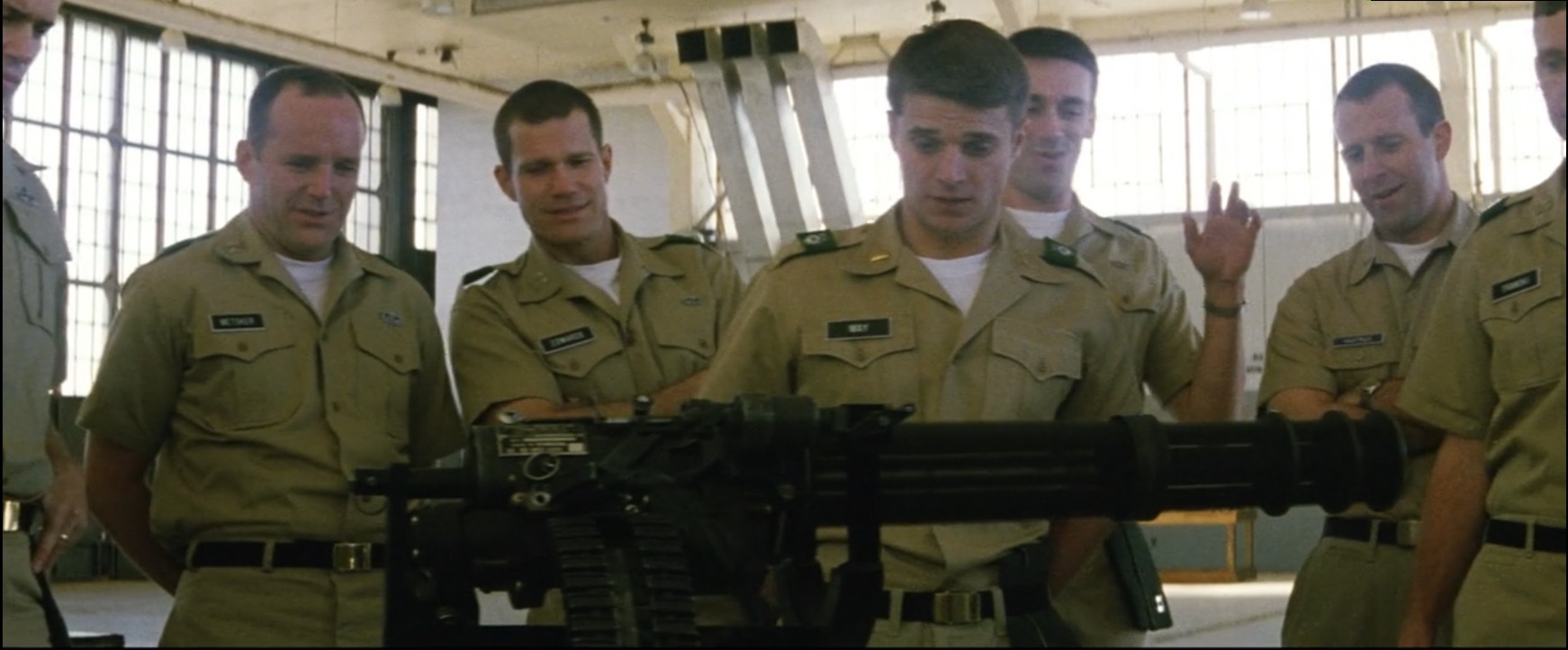
(The miniguns are teased in one of the hangers early in the movie being inspected by all the officers before being addressed by Moore.)
Other notable aircraft featured in the movie include the A-1H Skyraider, A-4 Skyhawk, and the A-6 Intruder. The A-1 was a piston powered attack aircraft that while slow compared to the jet fighters of the day, proved to be fantastic in the close air support or CAS role for its large carrying capacity and long loiter times, allowing it to stick around and help the men on the ground, much in the same way as the modern A-10. Both carrier based attack jets, the A-4 and A-6 also saw extensive use in the war, launching from ships offshore to attack targets inland with bombs, napalm, and cannon fire.
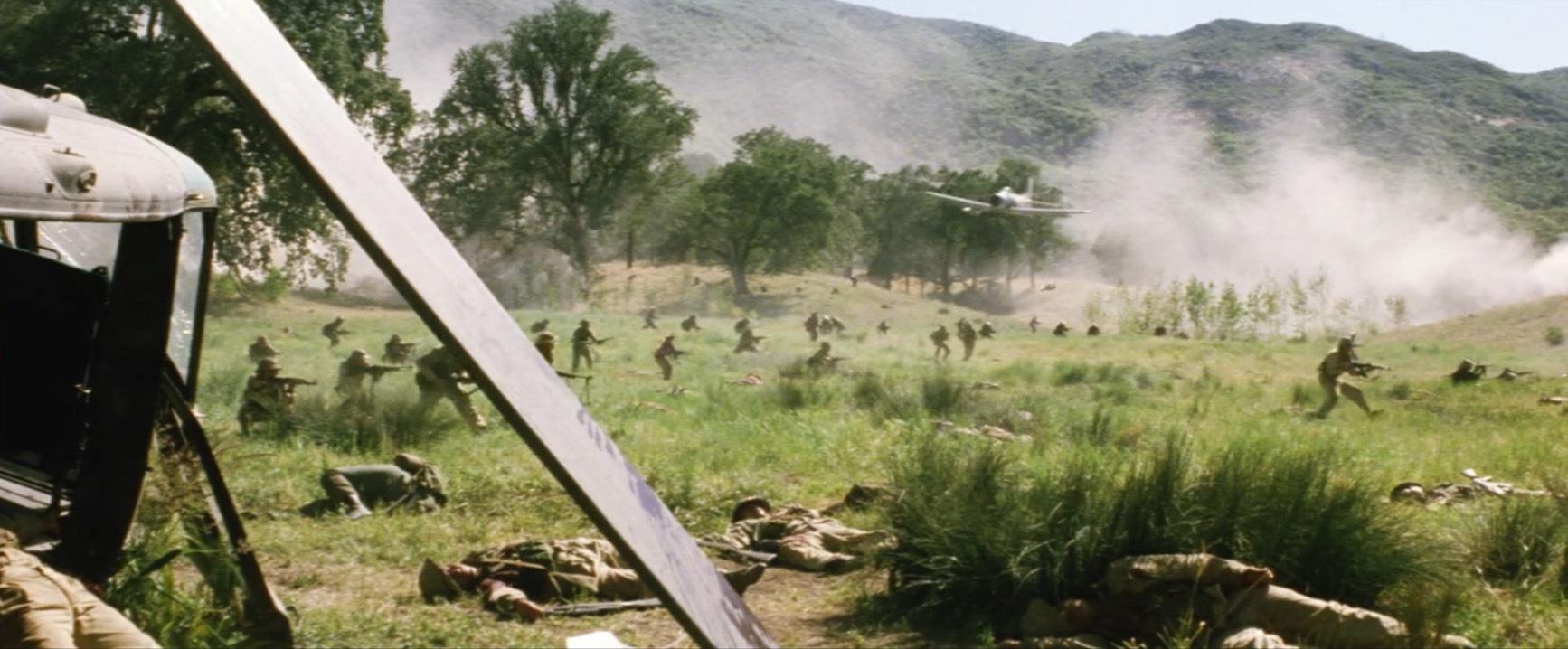
(An A-1 makes a showy and low run, dropping the devastatingly powerful napalm incendiary explosive on NVA infantry.)
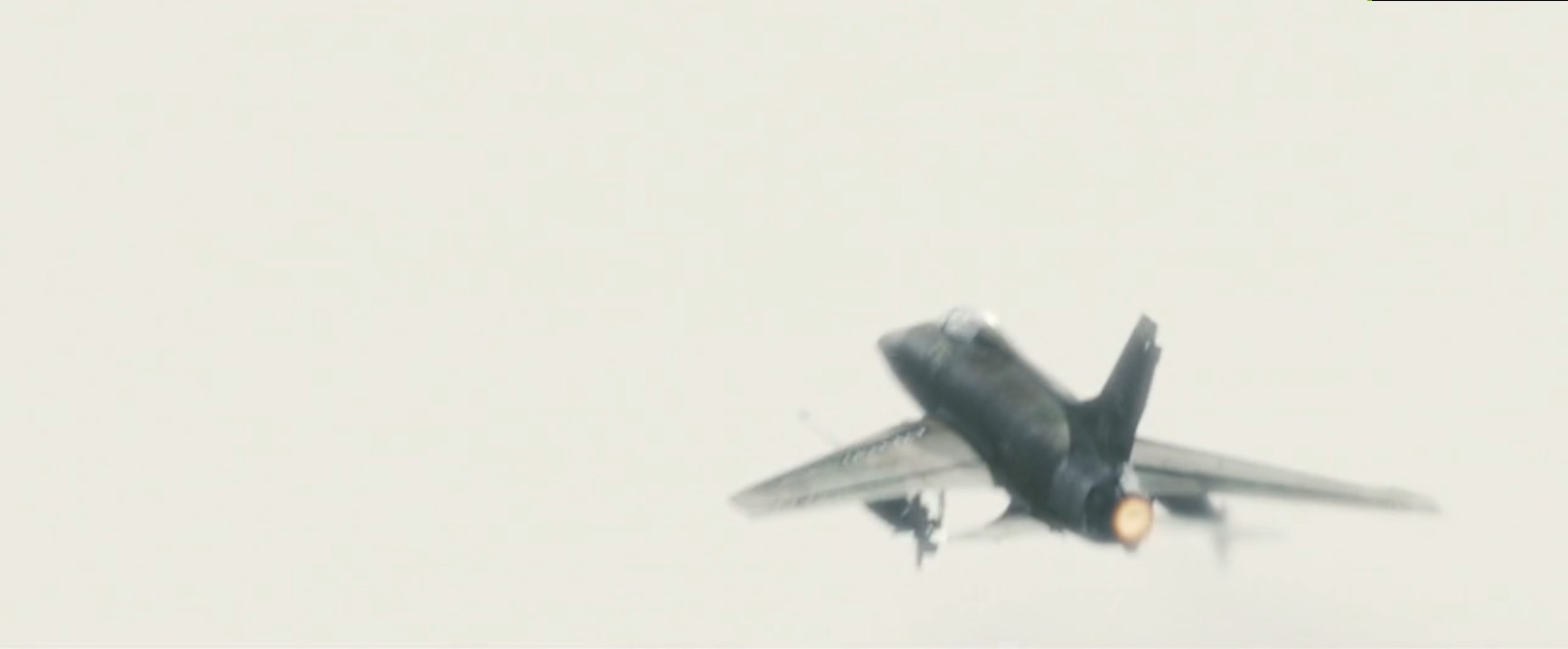
(An F100 Super Sabre takes off from a carrier to assist the now raging battle.)
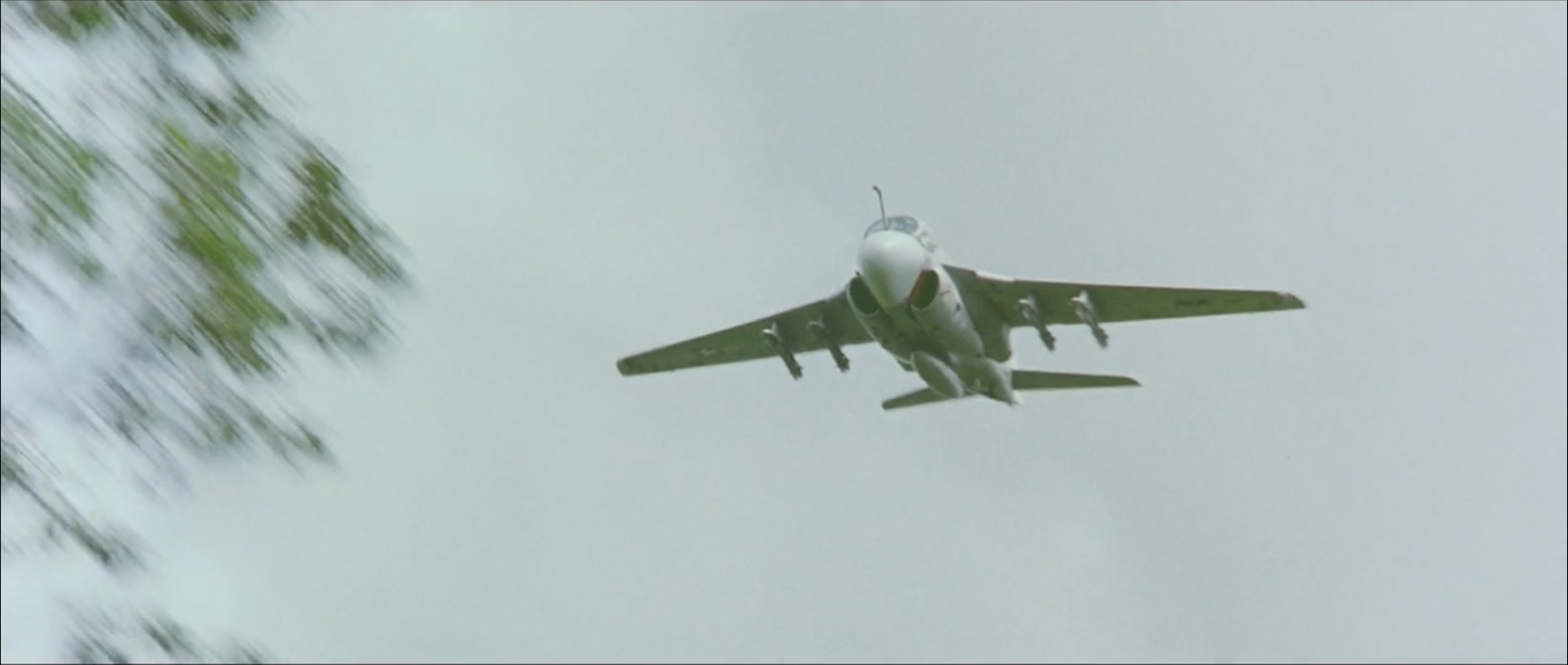
(After expending its ordnance, this A-6 flies over the battlefield back towards the carrier fleet.)
Small Arms
The number of world governments sending soldiers and military aid to Vietnam meant that a smorgasbord of small arms circulated during the country in use by both sides, many surplus from WWII while others carried brand new, cutting edge weapons sent to use specifically in the campaign.
After World War Two, militaries around the world sought to improve their soldier’s individual firepower through lessons learned on the battlefield. One common realization, made even by the Germans before and during WWII, was that most combat took place at relatively close ranges, typically below 300 meters. Most rifles of the time could take accurate shots out to 1000 meters and were considerably powerful in order to do so, despite this being a rare possibility that enemies could even be spotted that far away, much less fired at. Developing something that could bridge the gap between the pistol caliber, close range rapid firepower of the submachine gun and the long range punch and accuracy led to the now ubiquitous assault rifle concept. Using a cartridge that had the speed and velocity of a rifle round and the smaller size and recoil of pistol ammo, the intermediate caliber assault rifle could replace two weapons at once by allowing both controlled semi-automatic fire for longer ranges and fully-automatic fire (this combination is known as select fire) for close range and suppression, greatly increasing the firepower of the individual soldier.
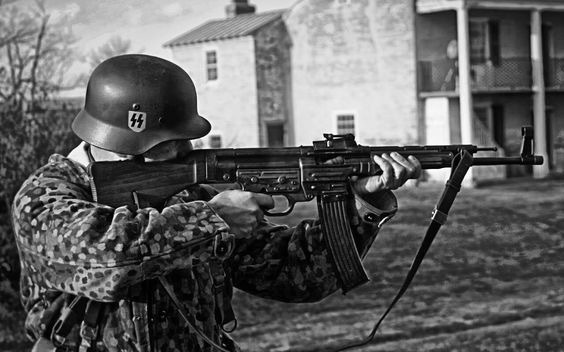
(A German soldier aims an STG-44, widely considered to be the first mass-produced assault rifle.)
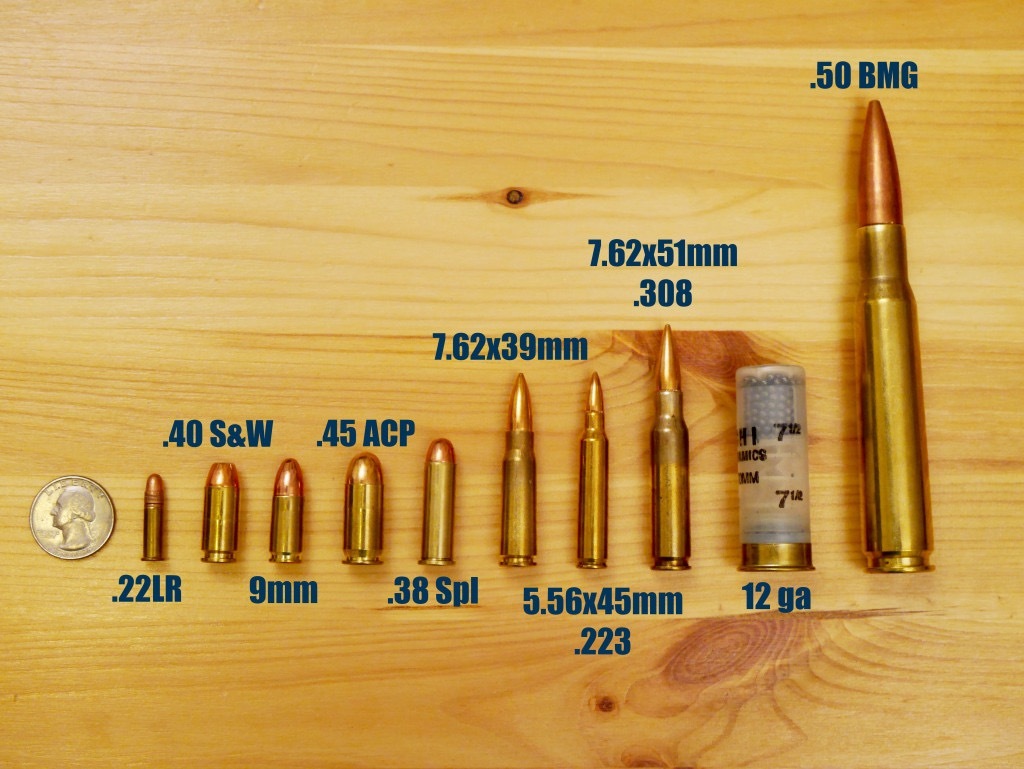
(Common calibers; pistol ammo like the 9mm, intermediate assault rifle like the 7.62x39 AK-47/AKM and 5.56x45 M-16/AR-15 ammo, 7.62x51 full rifle ammo, all the way up to the massive .50 caliber.)
Seeing the need for such a weapon was keenly felt by the Soviet Union, who prized the firepower and simplicity of submachine guns and wanted a replacement in a new, more powerful caliber similar in practice to the German STG-44 they had just fought against in WWII. After development of a new cartridge, the 7.62x39mm, a new set of weapons emerged to chamber it with the brand new AK-47 originally intended to replace the PPS-43 and PPSH-41 submachine guns of WWII. After realizing that the AK-47 was just as good, if not better than their semi-automatic rifle in the same caliber, the SKS, the AK-47 saw wide adoption, along with a more modern, easier and cheaper to manufacture variant using stamped sheet metal known as the AKM. These variants have been so widely produced that they are by far the most common infantry weapon in the world, seeing nearly constant use since their introduction. The now obsolescent SKS was given as military aid to countless countries and regimes that supported the communist cause, as well as the AK-47/AKM that supplanted it, seeing both on the opposite end of NATO and UN peacekeeping soldiers around the world, particularly in Vietnam.
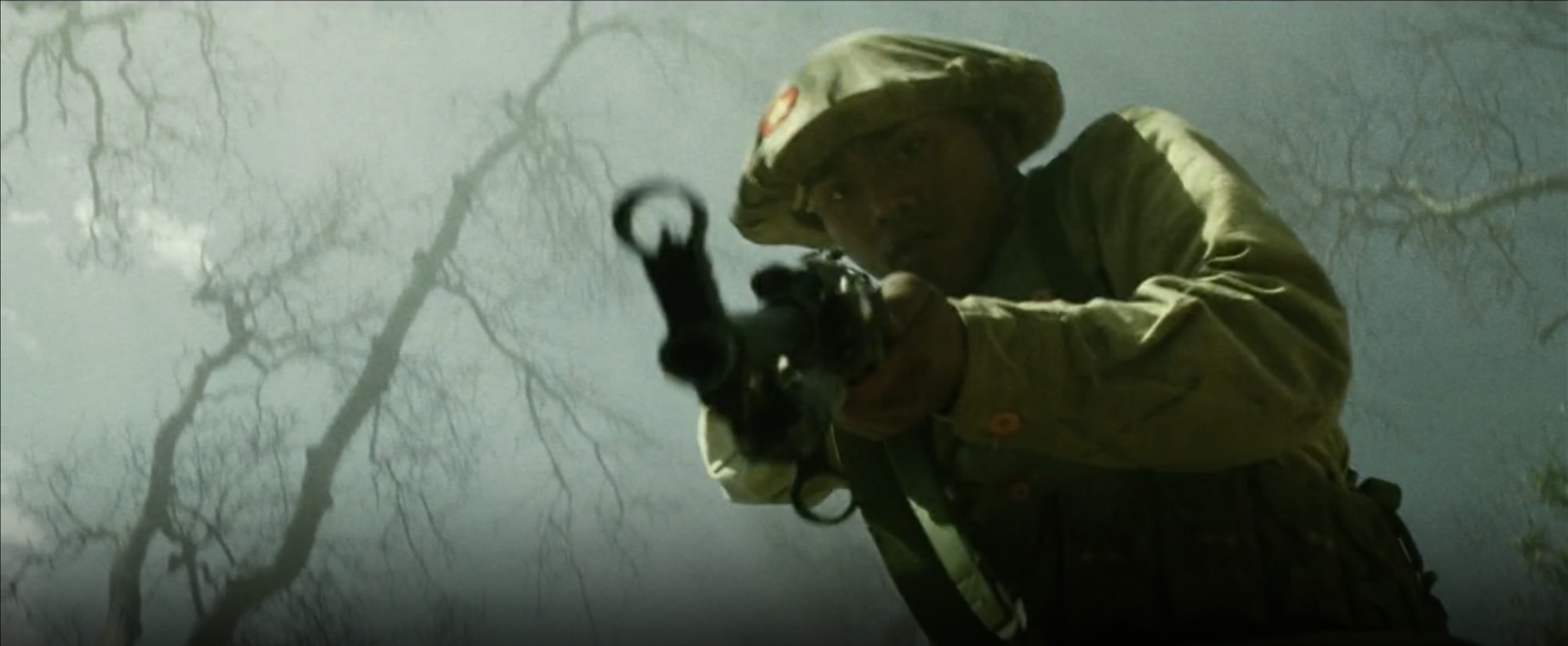
(An NVA soldier aims his SKS rifle at a French soldier in the opening scene.)
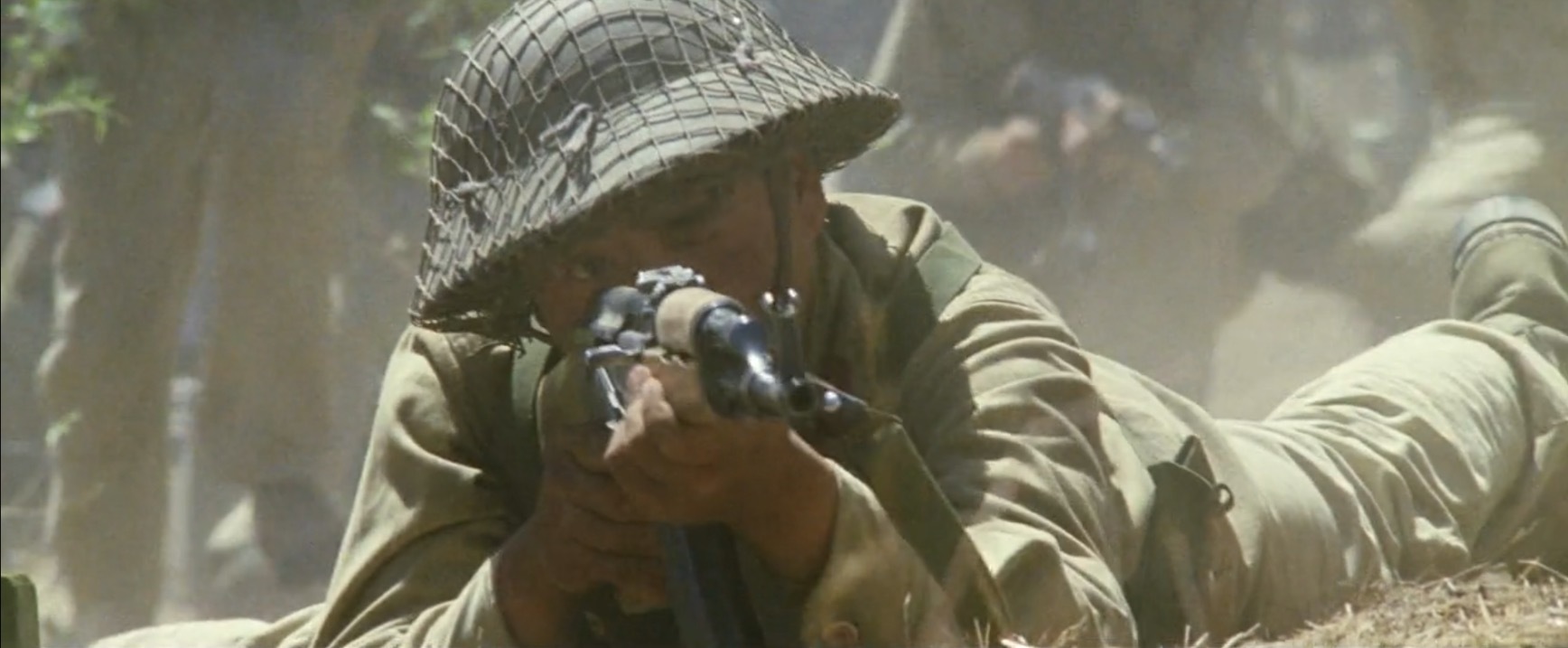
(As Moore and his men crest the hill, this soldier takes careful aim with his AK-47.)

(Echoing the opening scene of the French officer being bayoneted by an SKS, this NVA soldier attempts the same thing on Moore, only to be gunned down by a burst from his M16.)
Slower to the party, the US was keen on improving firepower, but was less interested in the assault rifle concept at first, hoping to maintain the range and power of their 30-06 cartridge in a smaller package, creating the new 7.62x51 NATO rifle cartridge, with a new, magazine-fed improved M1 rifle, the M14, to fire it. After the heavy and unwieldy M14 was introduced in 1957, the US involvement in the jungles of Vietnam and an Air Force desire for a controllable, select fire, carbine to replace their aging M2s, the experimental XM16 was adopted on a limited basis in 1963, later seeing full adoption as the standard infantry rifle of the United States. It fired a light but high velocity 5.56mm bullet from a 20 round magazine in full or semi-automatic out to a maximum effective range of 460 meters. While the bullet of the AK-47 is still rather fat and heavy, the M16’s ammo takes a different approach, leaning on the kinetic energy of the bullet being transferred into the target as it hits with enough speed to tumble and break apart, rather than simply punching straight through with minimal effect on the bullet. This gives the M16 significant wounding potential while keeping it light, easy to control, and easier to shoot at range as a faster and lighter bullet will have less drop, travelling with a flatter trajectory to its target. All of these qualities proved perfect for jungle fighting where a handy automatic carbine was valued for getting through the rough terrain, while its light ammunition sometimes let it down by deflecting off dense vegetation because of its reduced penetrative ability over something like an AK-47 or the M14. Early teething problems due in large part to a new type of gunpowder not used in testing found the M16 under intense scrutiny from the Army and even Congress, but after the powder was corrected and cleaning kits became standard issue again, the weapon performed admirably, with a slightly shorter carbine variant, the M4, still in active use today.
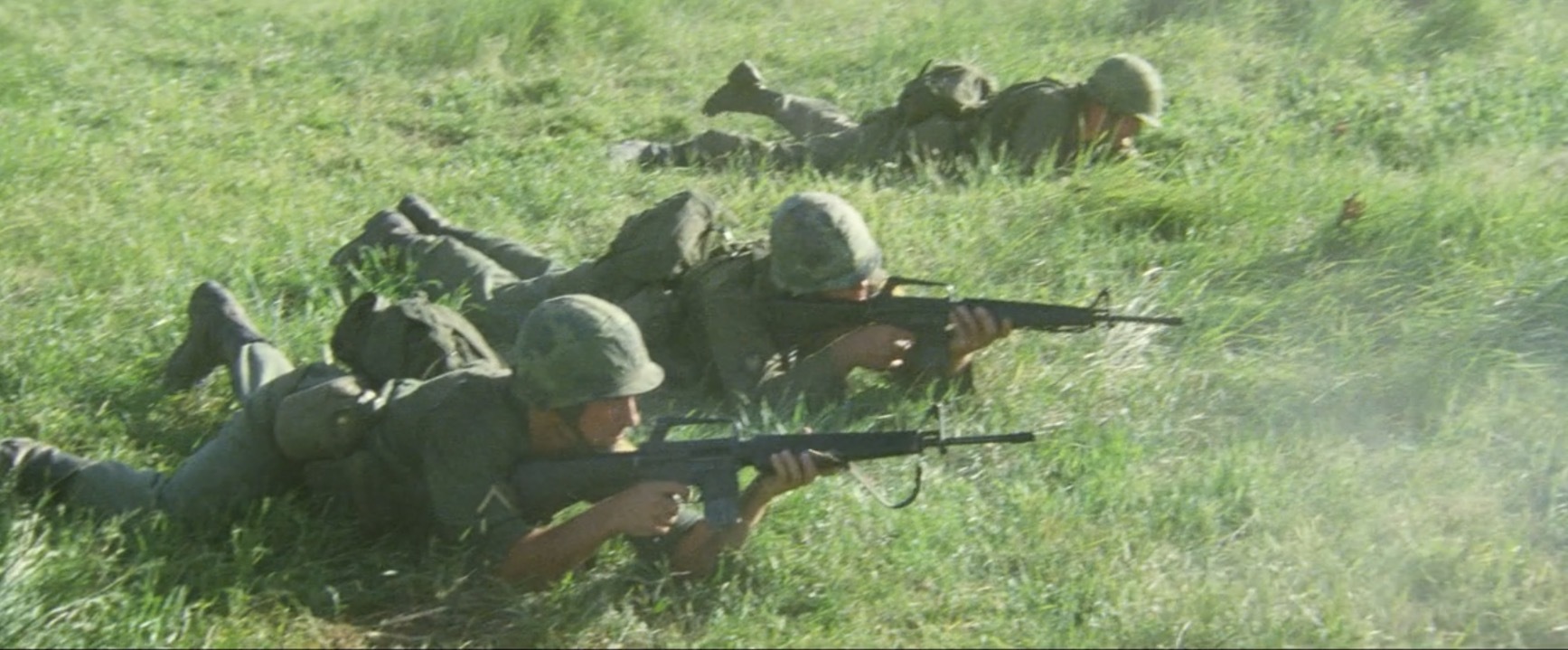
(Troopers return fire with their M16s after landing to help secure the LZ.)

(Moore flips the safety on his M16 from SAFE to AUTO while still in the Huey. As Micah pointed out, this is unnecessarily risky as doing so takes a fraction of a second.)
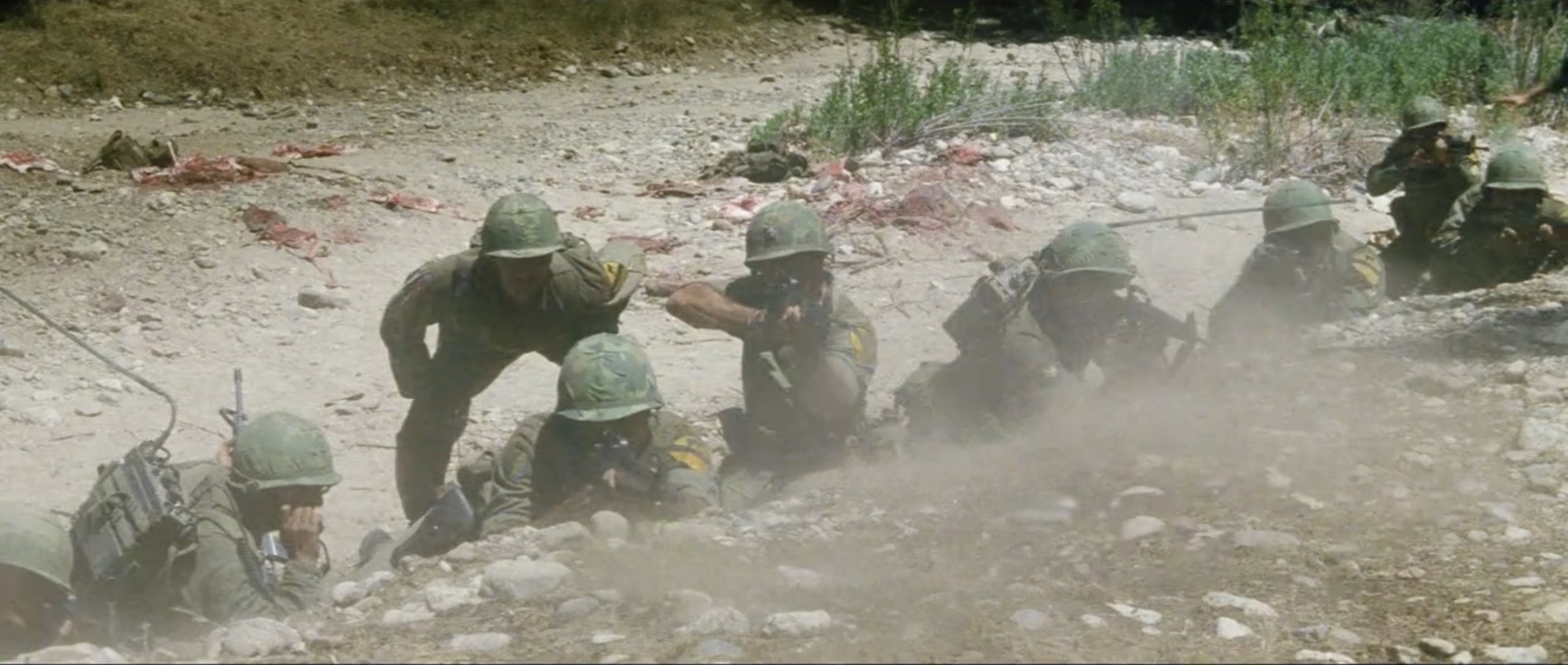
(After some recon by fire, US soldiers protect the dry creek bed with blistering fire from their M16s. Often shown spraying them in full auto, the movie encapsulates the fears that military planners and designers hoped to quell with the M16A2’s 3 round burst feature, hoping to limit the amount of ammo a soldier could expel needlessly. This has since been deleted on the current M4A1s, reverting to SAFE, SEMI, and AUTO with semi-automatic being used most often.)
After the introduction of the 7.62 NATO and seeing the success of the general purpose machine gun concept in the guise of the German MG-34 and MG-42 machine guns, the US sought to create their own versatile machine gun to replace the bulky yet dependable M1919 series of guns. Taking direct inspiration from the reliable and simple belt feed system of the MG-42 along with the internal components of the curious FG-42 automatic rifle, the M60 machine gun was born and adopted on 1957 alongside the M14, with the two weapons hoping to replace the submachine gun, rifle, carbine, automatic rifle, and machine gun. In reality, the M60 was successful in replacing the automatic rifle (BAR) and machine gun (M1919) but the M14 only really replaced the rifle (M1). Light enough for a single man to use but also capable of being mounted on a tripod for long range engagements and in vehicles on a fixed mount, the M60 lived up to the title of a general purpose machine gun, seeing admirable use in all branches and all over the world. Nicknamed “The Pig” for its weight and appetite for ammo, the M60 was valued for its firepower and ability to suppress the enemy, allowing soldiers to maneuver or escape an ambush. Its most prolific use was in the Vietnam war, being the standard issue machine gun of the US at the time, but it went on to serve well into the 21st century despite being officially replaced by the heavier, more durable, M240 in the late 90s.
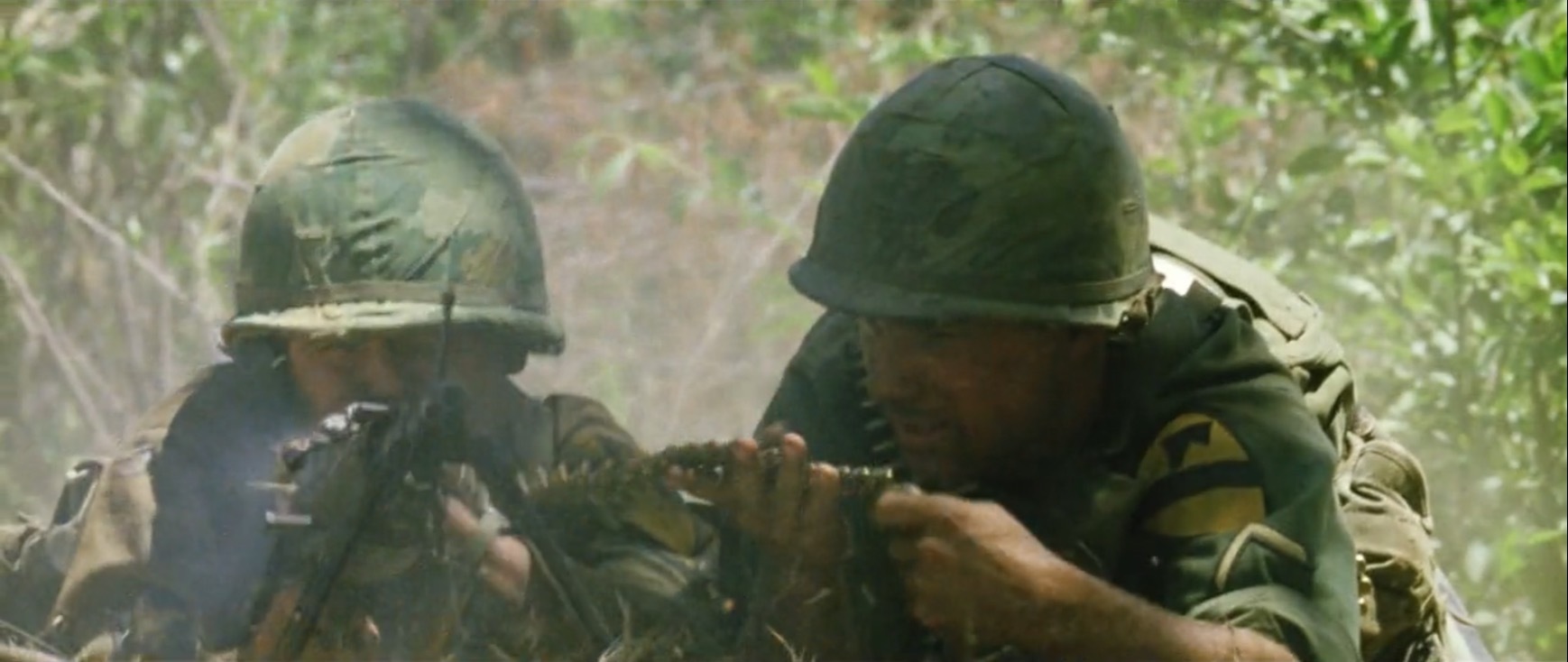
(An M60 machine gun team guns down charging NVA soldiers, fulfilling its fire support role. The assistant gunner carries extra ammo and ensures the belts of ammo feed into the gun correctly.)
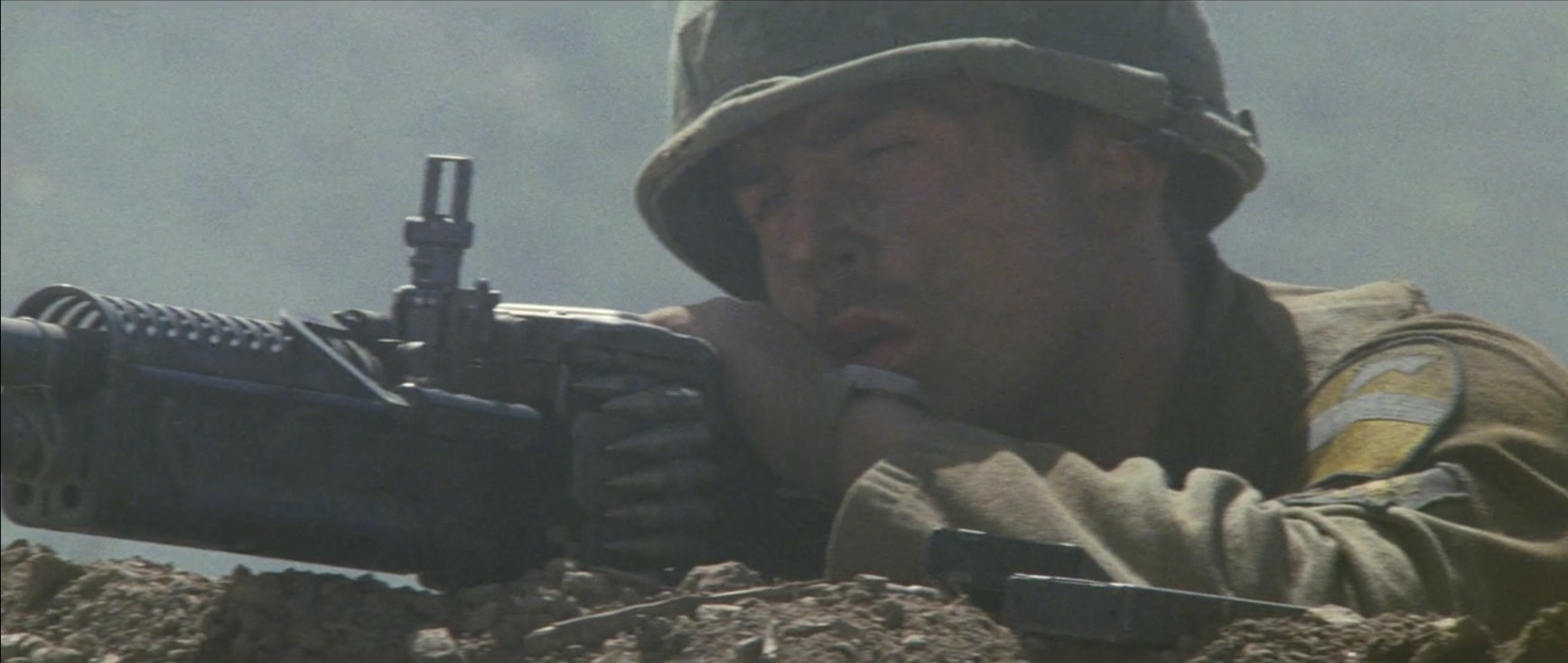
(A gunner keeps an eye out for NVA counter-attack on the ridge.)
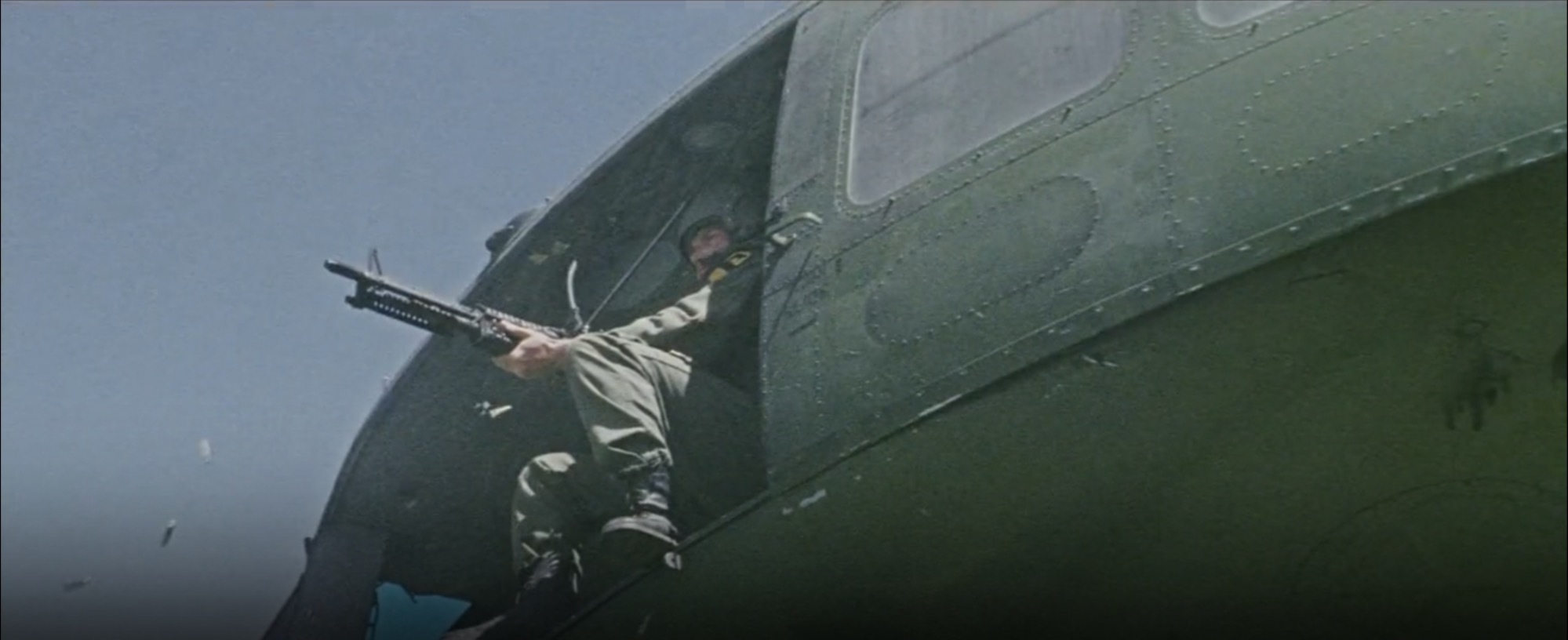
(A door gunner of a Huey provides covering fire as they take off. Being able to dismount and use the gun immediately in a pinch was helpful to surviving a crashed helicopter.)
Other Noteworthy Weapons In Screenshots
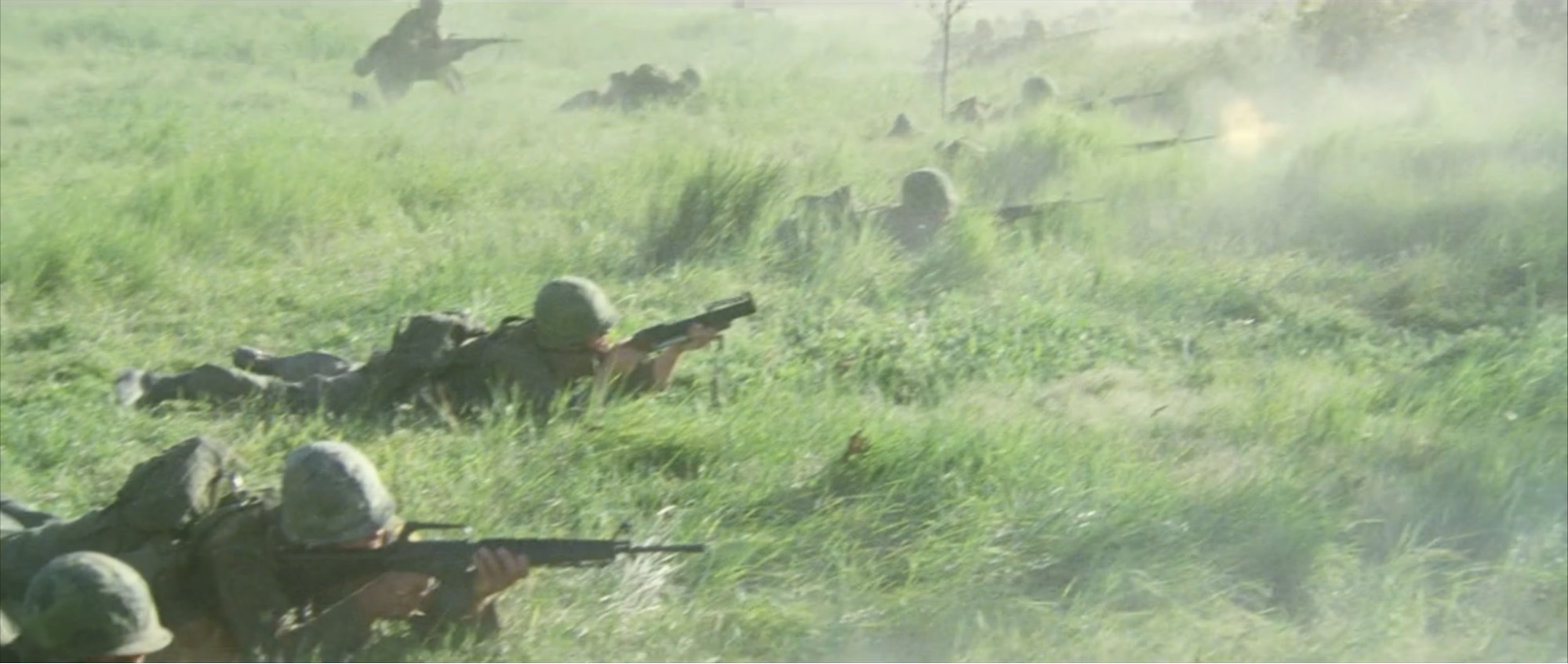
(The soldier in the middle fires his M79 grenade launcher at the LZ. The new 40mm grenade firing weapon gave the squad mobile explosive power at the cost of a rifle, a problem quickly remedied by the under barrel mounted M203 grenade launcher firing the same ammunition.)
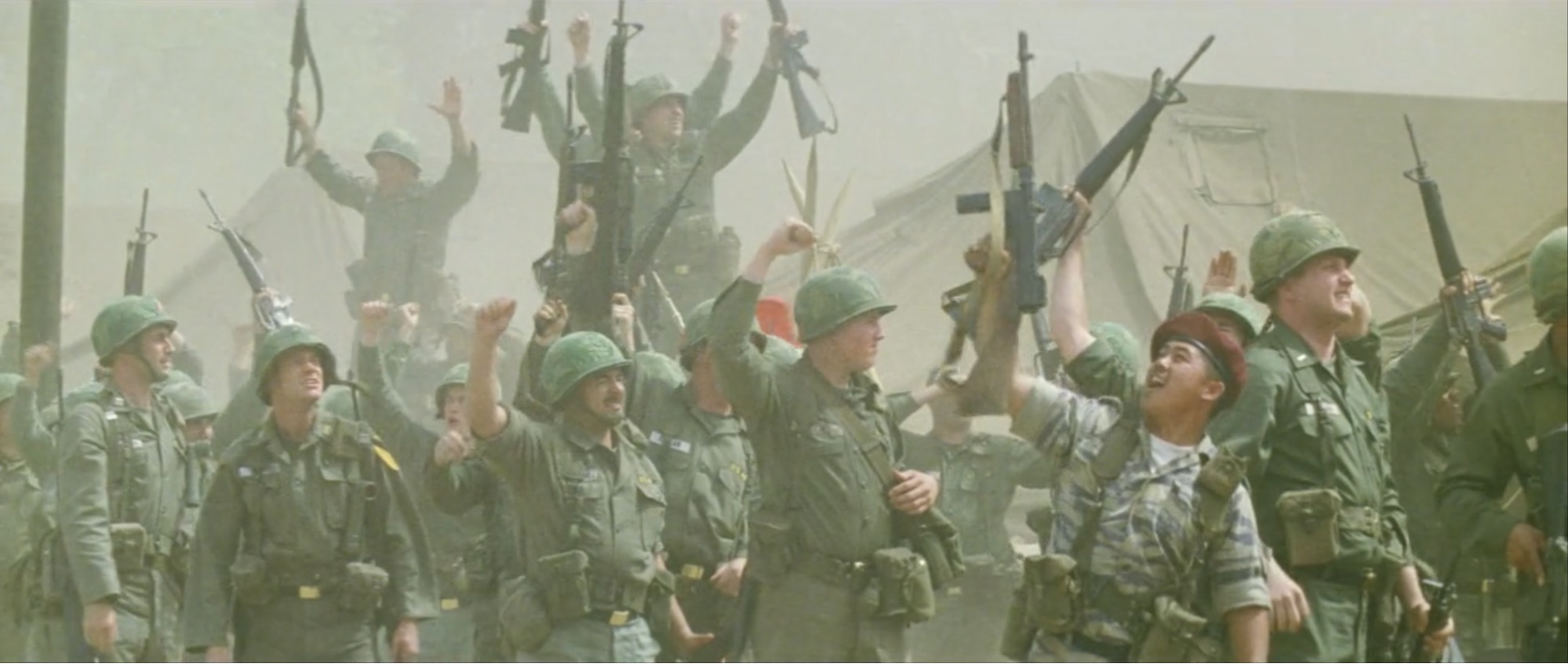
(Despite the goofy guns raised nature of this scene, it highlights the red beret wearing ARVN soldier’s use of American surplus WWII weaponry, notably his M1a1 Thompson submachine gun.)
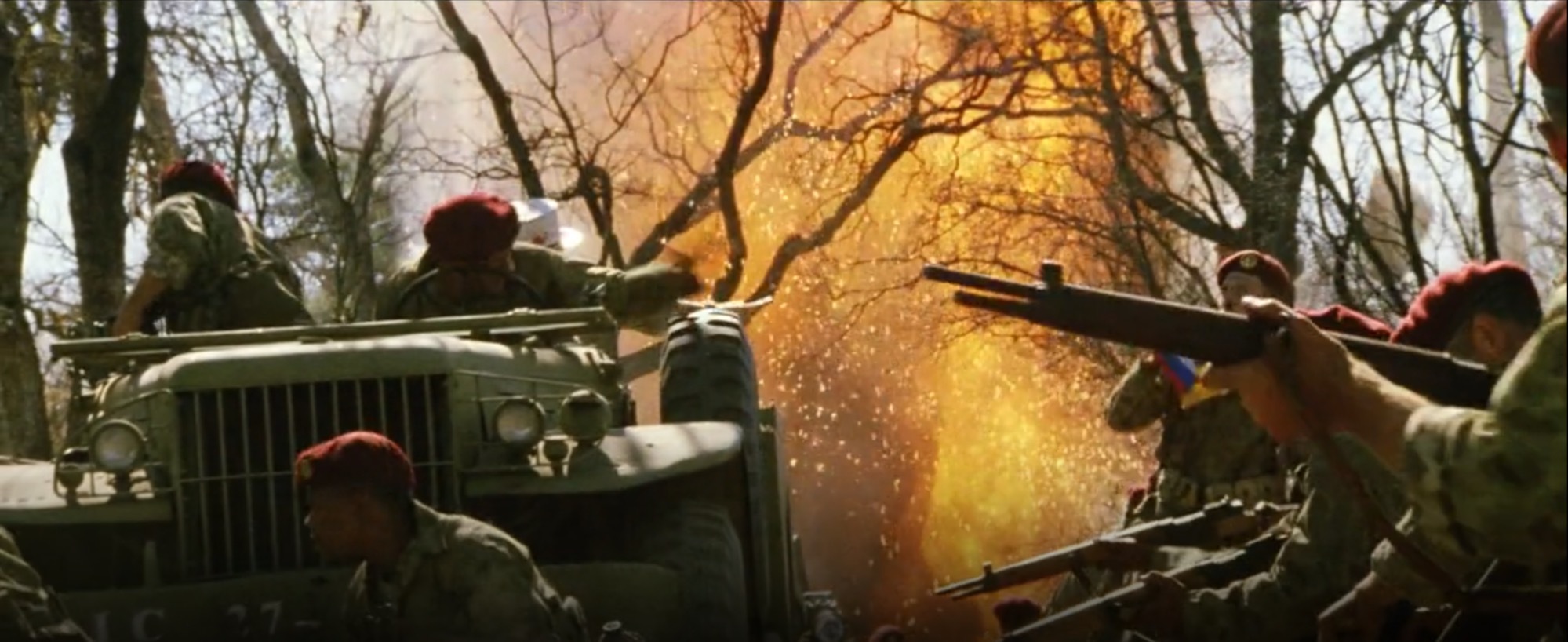
(Caught in an ambush, these French soldiers return fire with their WWII era MAS-36 bolt action rifles against the onslaught of Vietnamese attackers.)
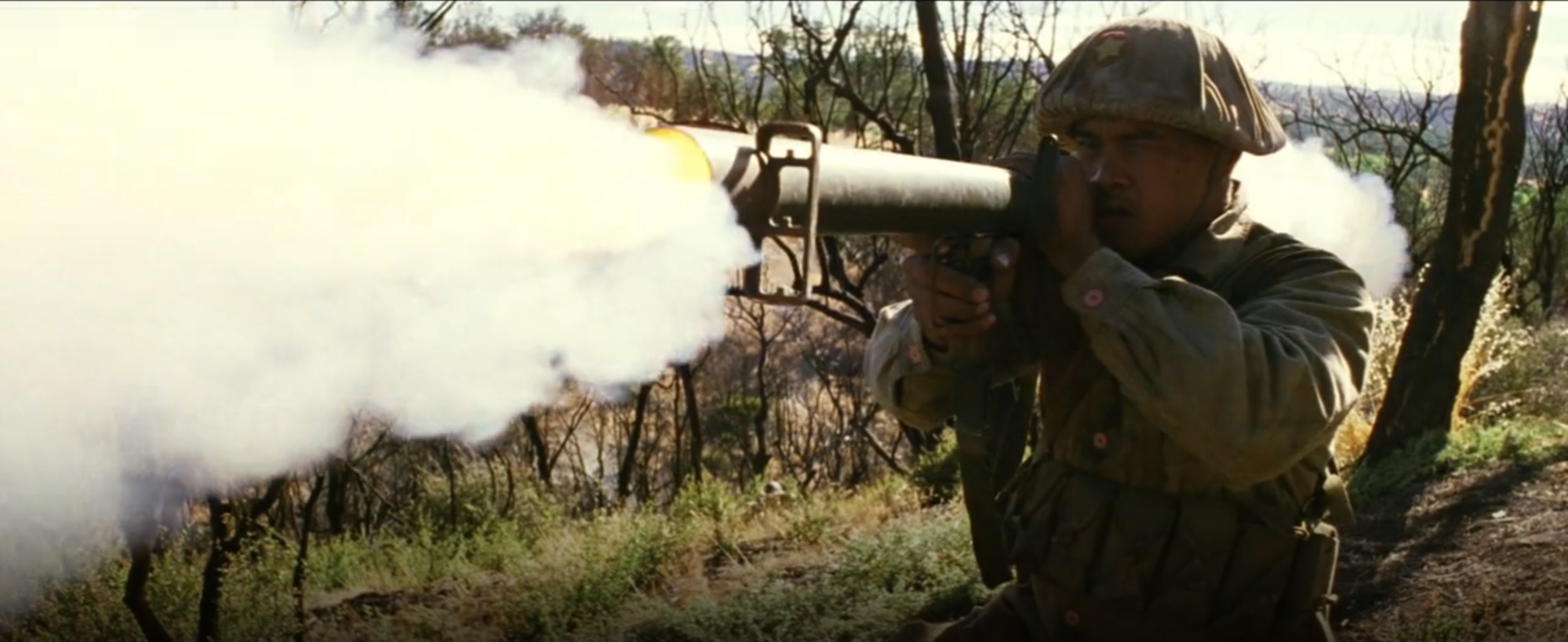
(Highlighting the use of captured weapons, this NVA soldier destroys a French jeep with an American, but French issued, M1A1 Bazooka.)
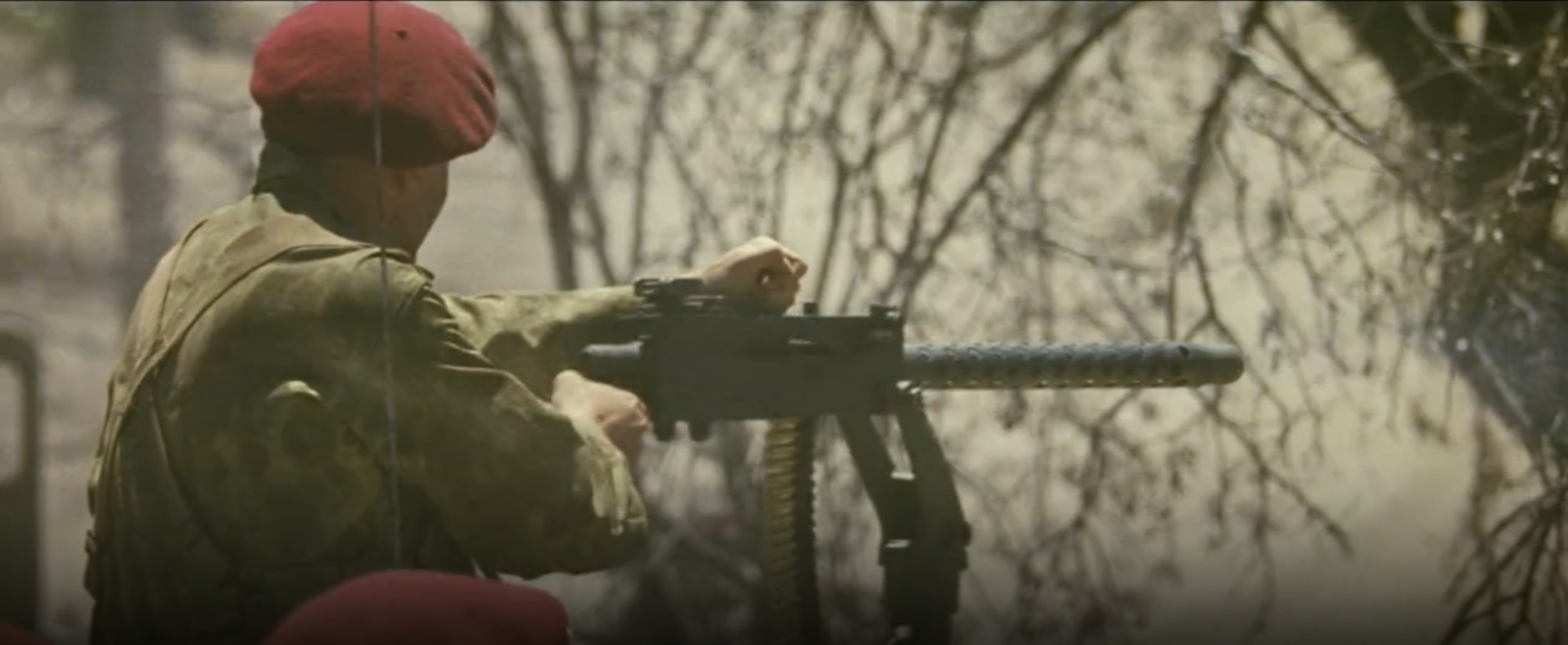
(Another WWII era weapon, the aforementioned 1919A4 is used by the French soldier in this jeep. Many of the post-war French army’s weapons were borrowed as surplus from the US until they could fully rearm with domestically produced replacements.)
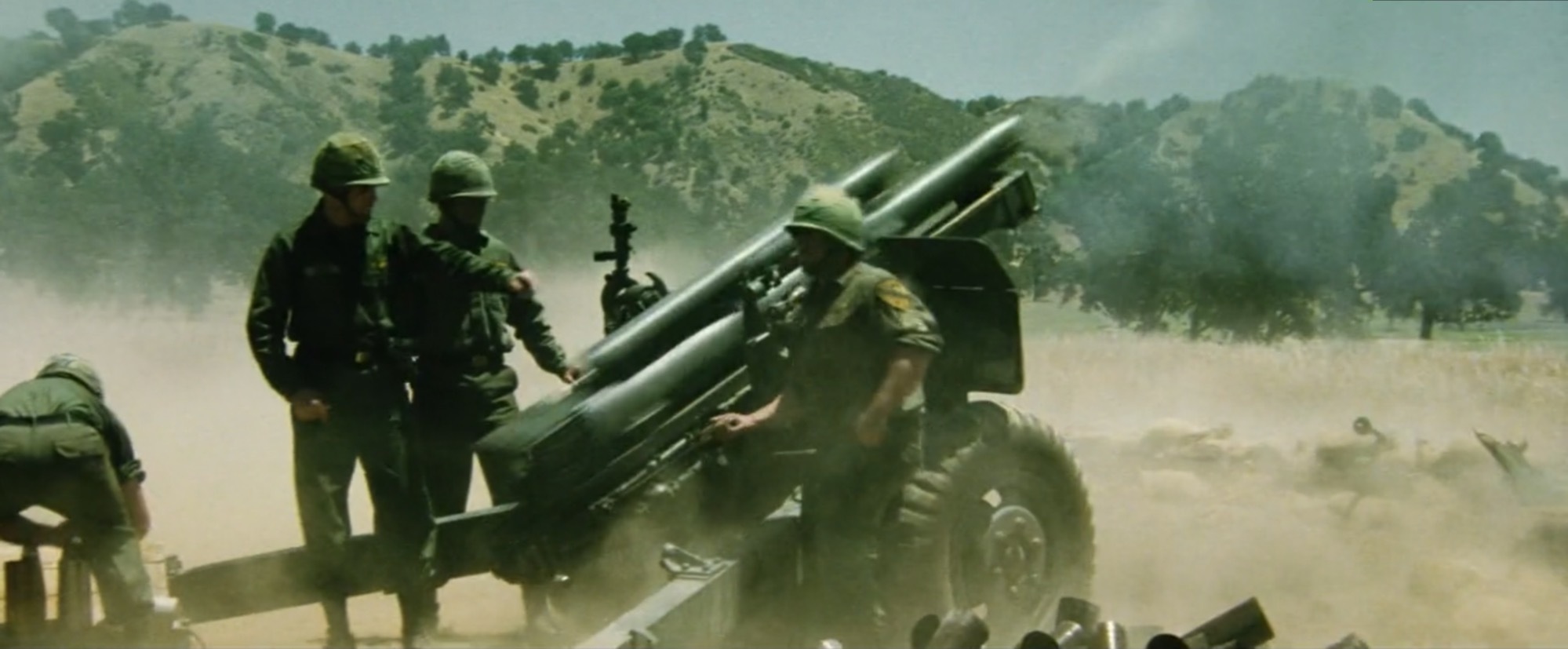
(105mm M101 howitzers provide the devastatingly accurate fire support the soldiers needed to avoid being overrun.)
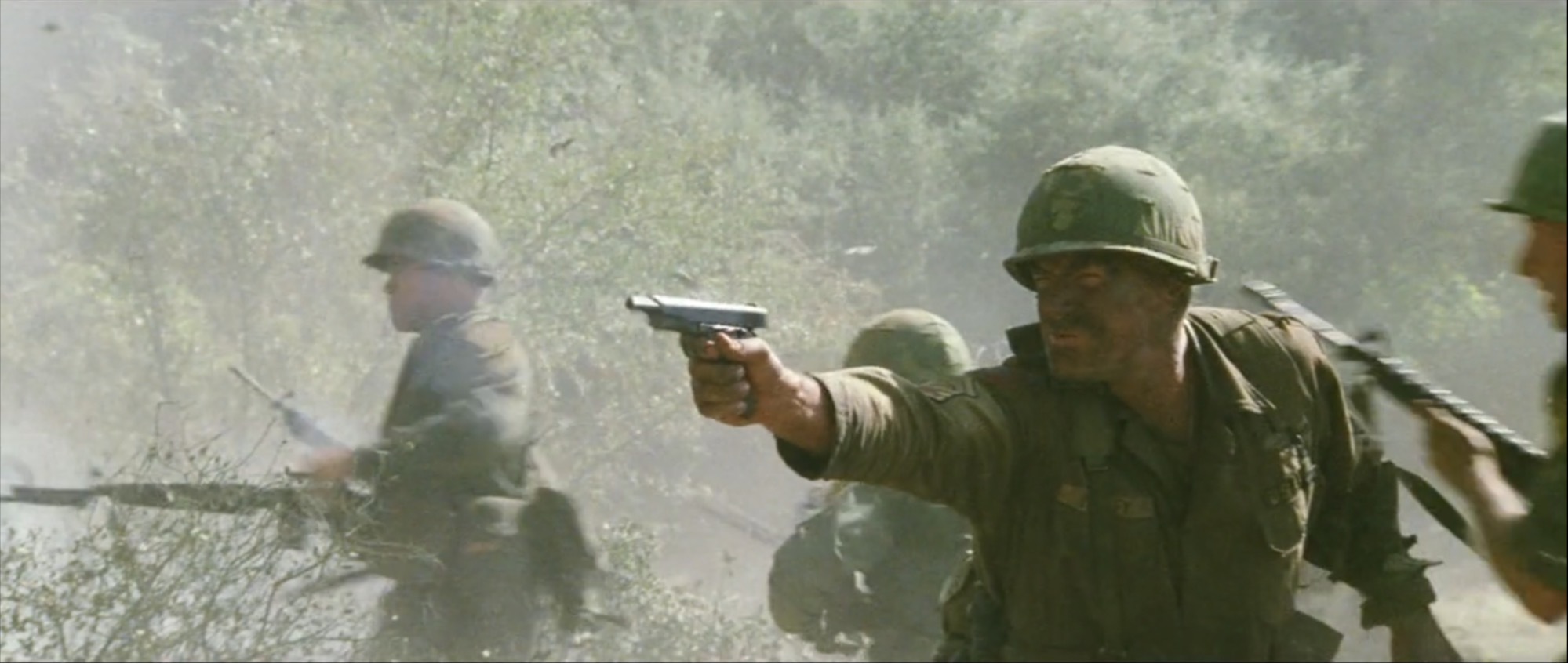
(Ever the stand-in for the grizzled old war vet, Plumley exemplifies this stereotype by choosing to carry only his .45 1911 handgun instead of the “bb gun” like M16. In reality, he also carried an M14 rifle into the battle.)
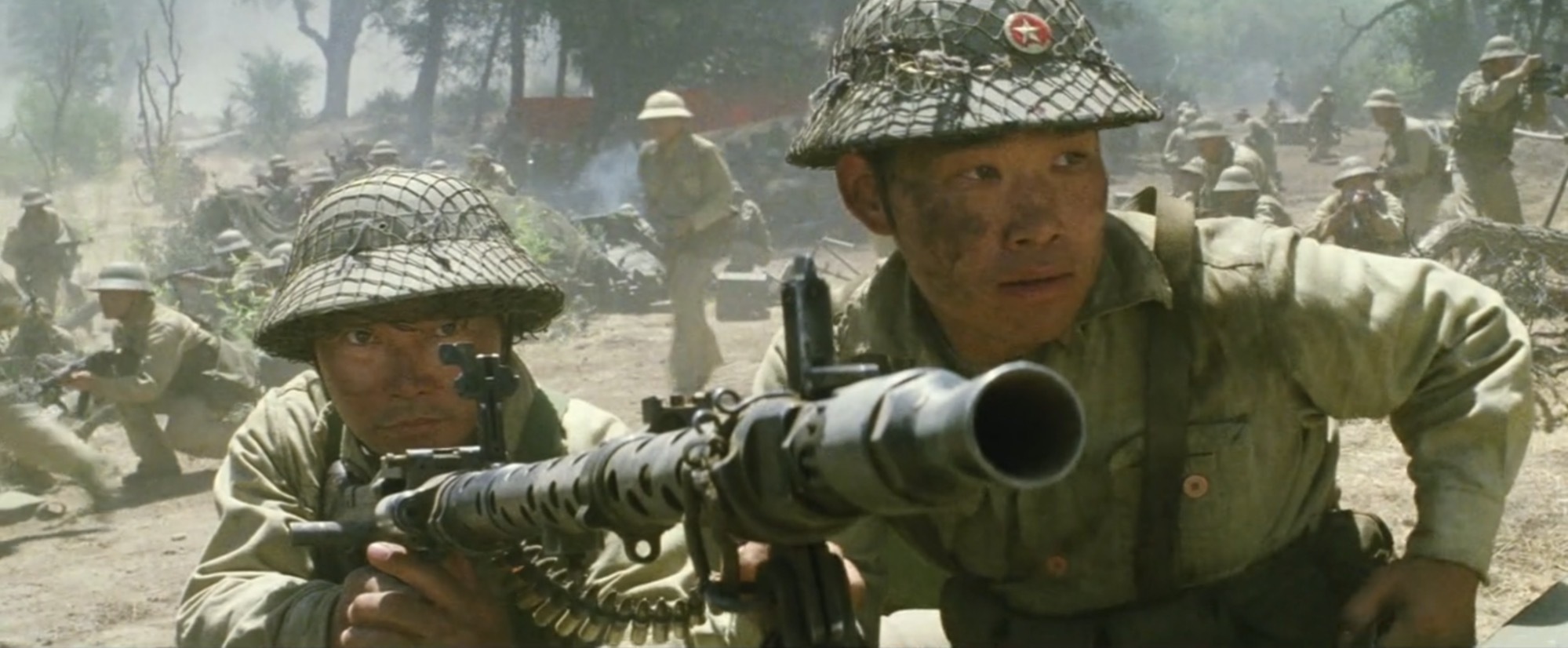
(Ready for the American charge, this MG-34 team sits ready to fire. Large numbers of captured MG-34s captured by the Soviets made their way into Vietnam and used to great effect.)
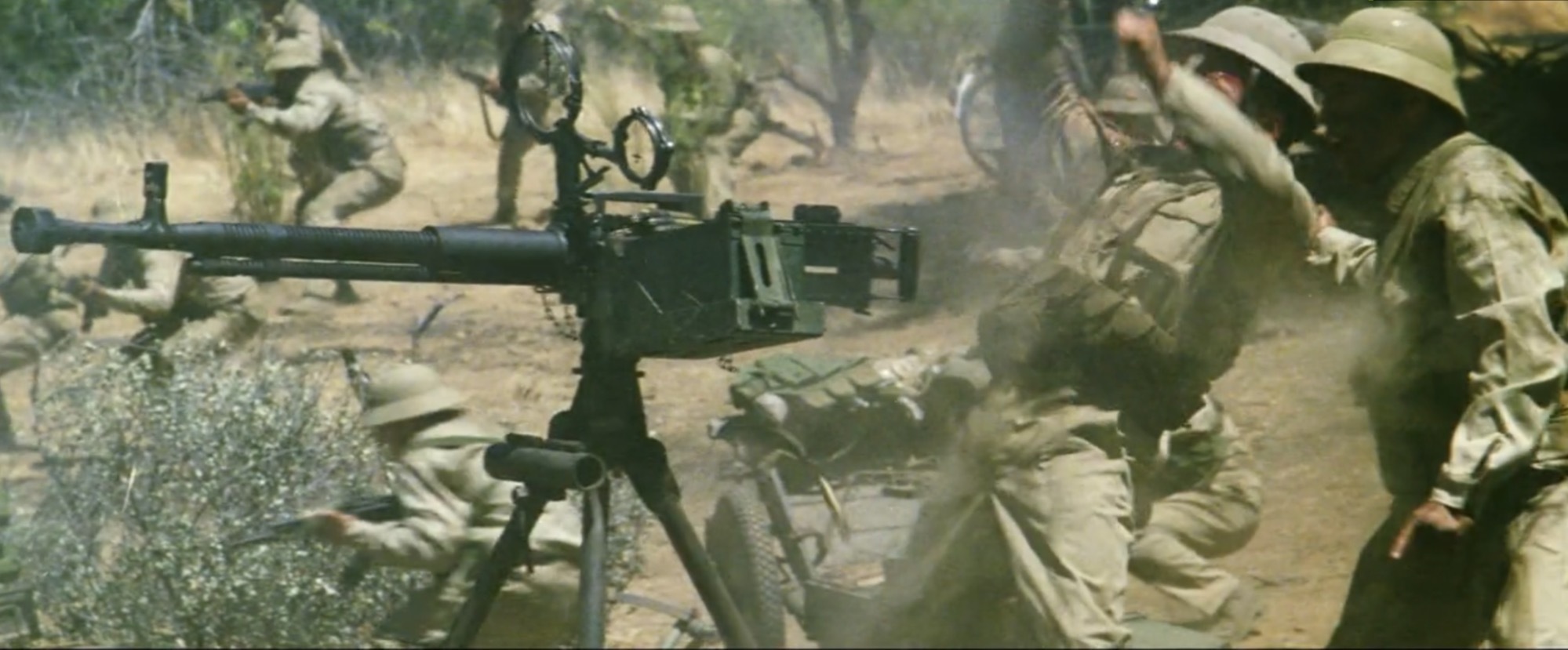
(A DShK heavy machine gunner is killed by Snake shit’s miniguns. A WWII era Soviet design, the DShK continues to see rugged use in the Middle East. This example is an American M2 .50 caliber machine gun made to look like a DShK.)
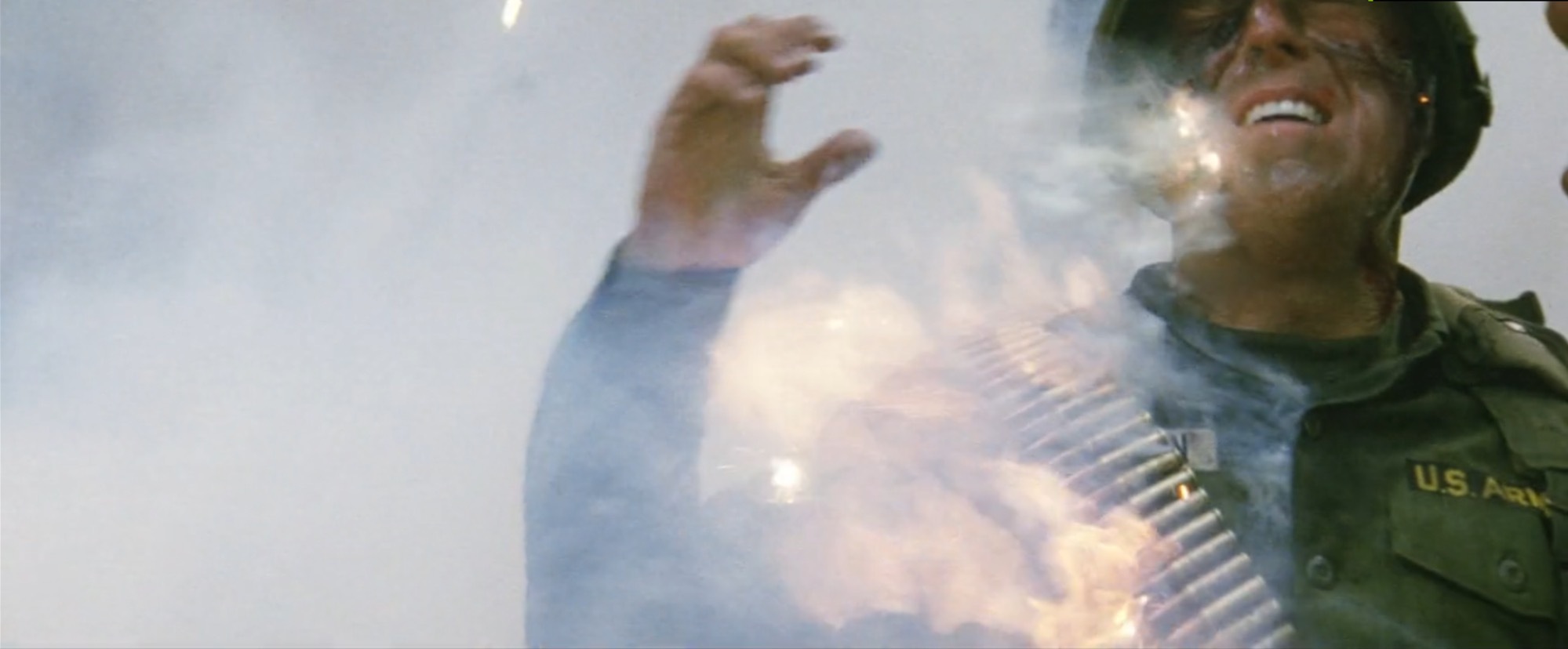
(Sgt Forrester is severely injured by an M34 White Phosphorus, or “Willie Pete,” grenade. Once detonated, the sticky, hot burning phosphorus burns its way through anything in its path, releasing a bright white smoke useful for marking enemy positions.)
References
The M16 by Gordon L Rottman
Helicopter Gunships: Deadly Combat Weapon Systems by Wayne Mutza
US Helicopter Pilot In Vietnam by Gordon L Rottman
US Grenade Launchers by Gordon L Rottman
The AK-47 by Gordon L Rottman
The M60 Machine Gun by Kevin Dockery
http://www.imfdb.org/wiki/We_Were_Soldiers
